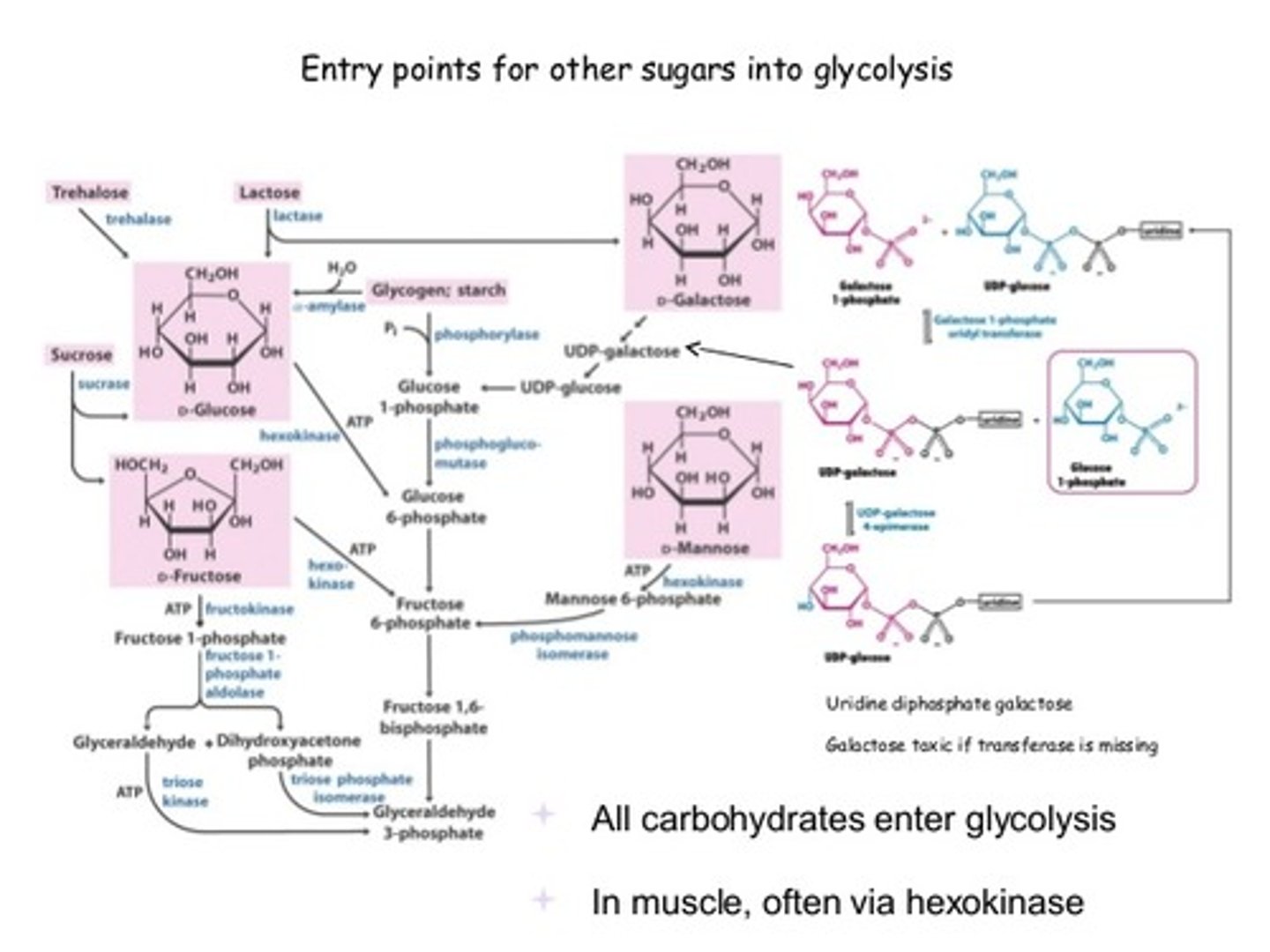Biochemistry II Module of the MCAT Self Prep eCourse: Lesson 1: Glycolysis and Gluconeogenesis (Pro)
1/56
There's no tags or description
Looks like no tags are added yet.
Name | Mastery | Learn | Test | Matching | Spaced |
|---|
No study sessions yet.
57 Terms
Lesson 1: Glycolysis and Gluconeogenesis
Lesson 1: Glycolysis and Gluconeogenesis
NOTE: Quizlet cards marked with CRB indicates that these flashcards cover the content found in the Content Review Books. Cards not marked with CRB cover the video playlist content. Enjoy! :)
NOTE: Quizlet cards marked with CRB indicates that these flashcards cover the content found in the Content Review Books. Cards not marked with CRB cover the video playlist content. Enjoy! :)
CRB Both Glycolysis and Gluconeogenesis are intimately related to Glucose and GLUT Transporters.
True or false? Disrupting the Insulin/GLUT 2 Mechanism can cause Diabetes Mellitus.
False. Disrupting the Insulin/GLUT 4 Mechanism can cause Diabetes Mellitus.
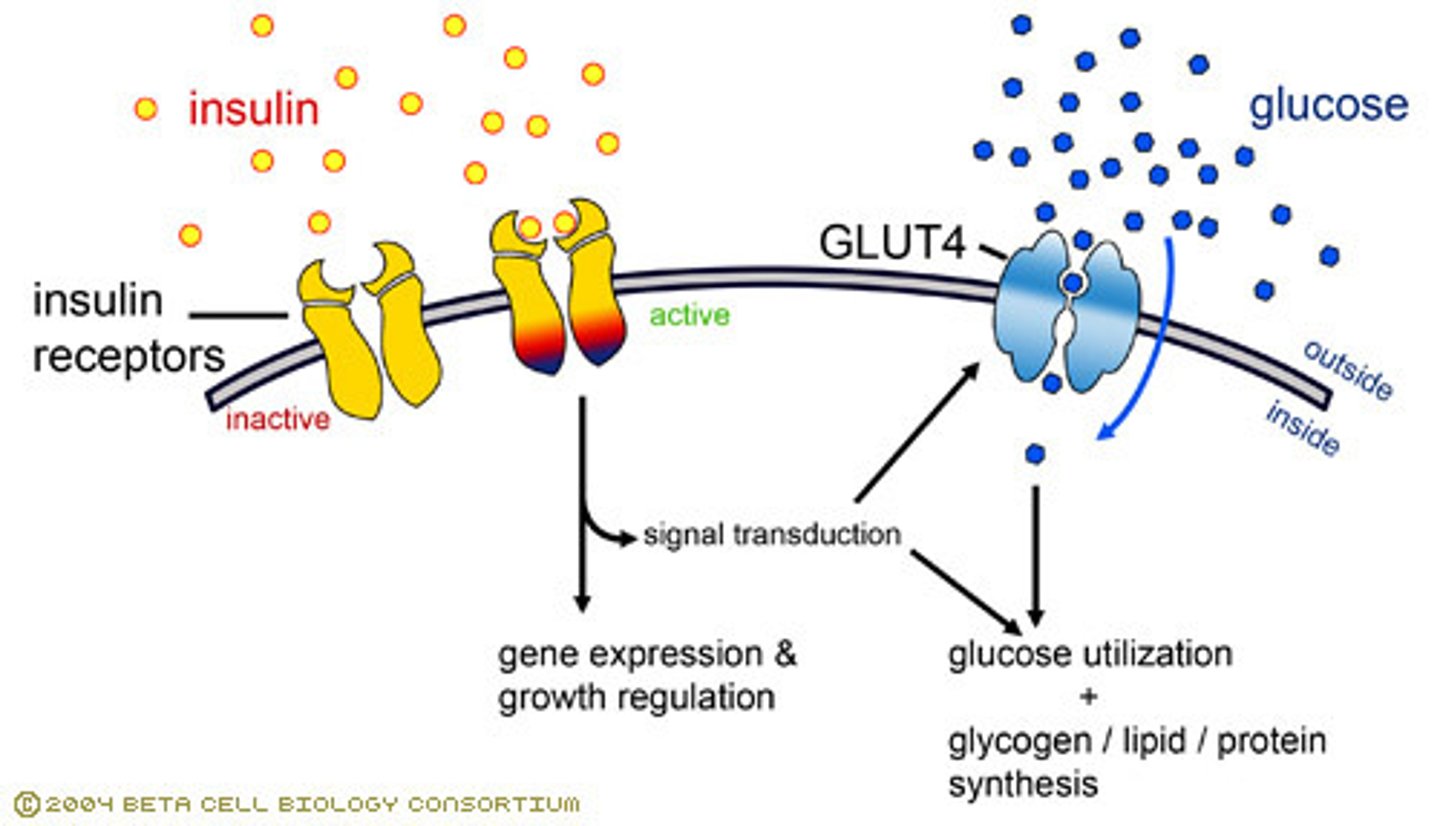
CRB Compare how Type I and Type II Diabetes Mellitus effect the Insulin/GLUT 4 Mechanism.
In Type I Diabetes Mellitus, the Insulin itself isn't produced and can't stimulate the the insulin receptor, which would bring GLUT 4 transporters to the cell membrane.
In Type II Diabetes Mellitus, the insulin receptors are desensitized to Insulin. Insulin is trying to signal to bring GLUT 4 transporters to the cell membrane; the receptors are at fault here.
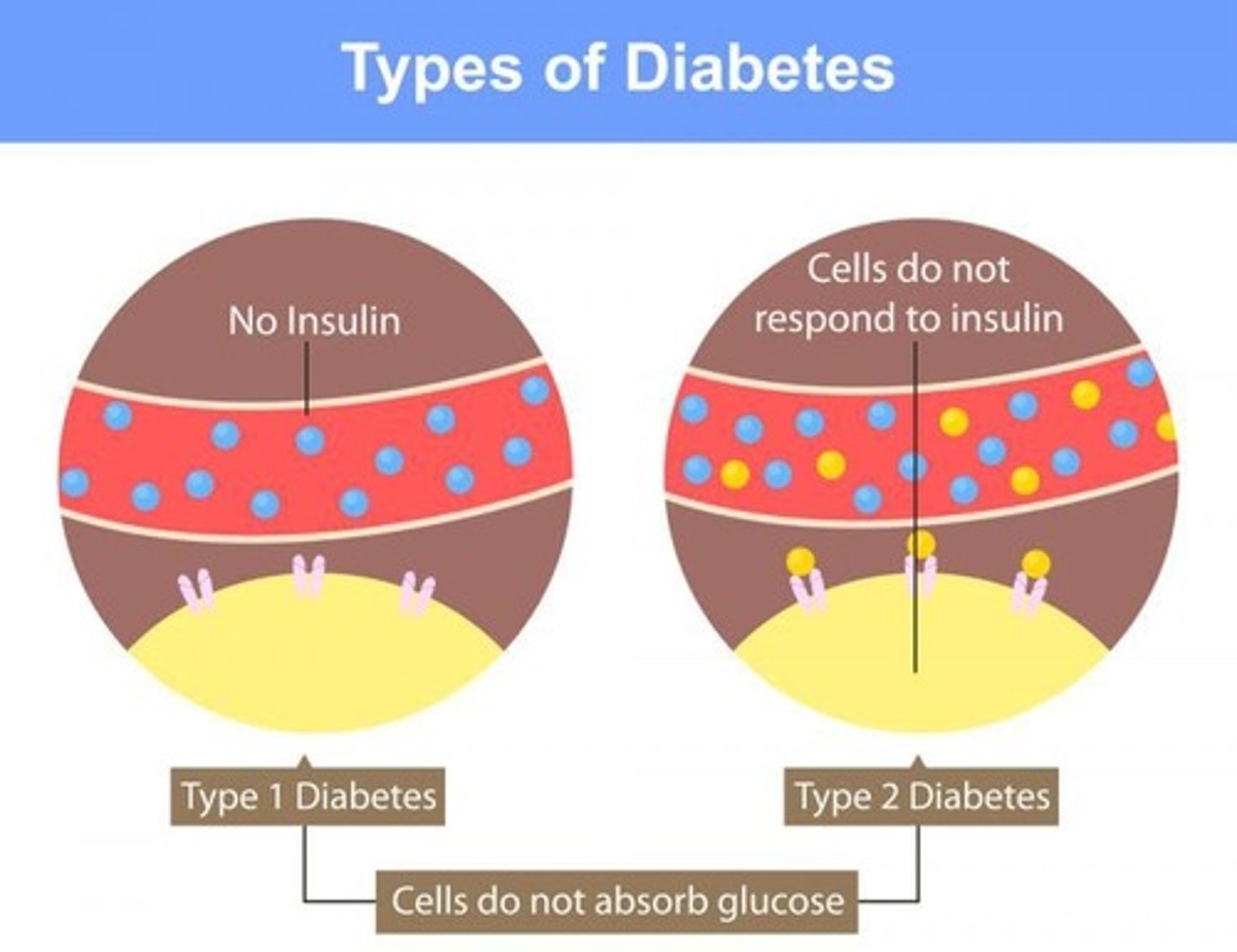
What is the correct order in which cellular respiration takes place?
I. Krebs Cycle
II. Glycolysis
III. Electron Transport Chain
(A) I, III, and II
(B) II, III, and I
(C) II, I, and III
(D) I, II, and III
(C) II, I, and III
Glycolysis takes place first then goes into the Krebs cycle, then finally into the electron transport chain.
Struggling to memorize the metabolic pathways (such as glycolysis and beta-oxidation)? Learn them like the back of your hand using Andrew's Metabolic Pathways Mastery Course @ https://mcatselfprep.com/course/andrews-metabolic-pathways-mastery-course/
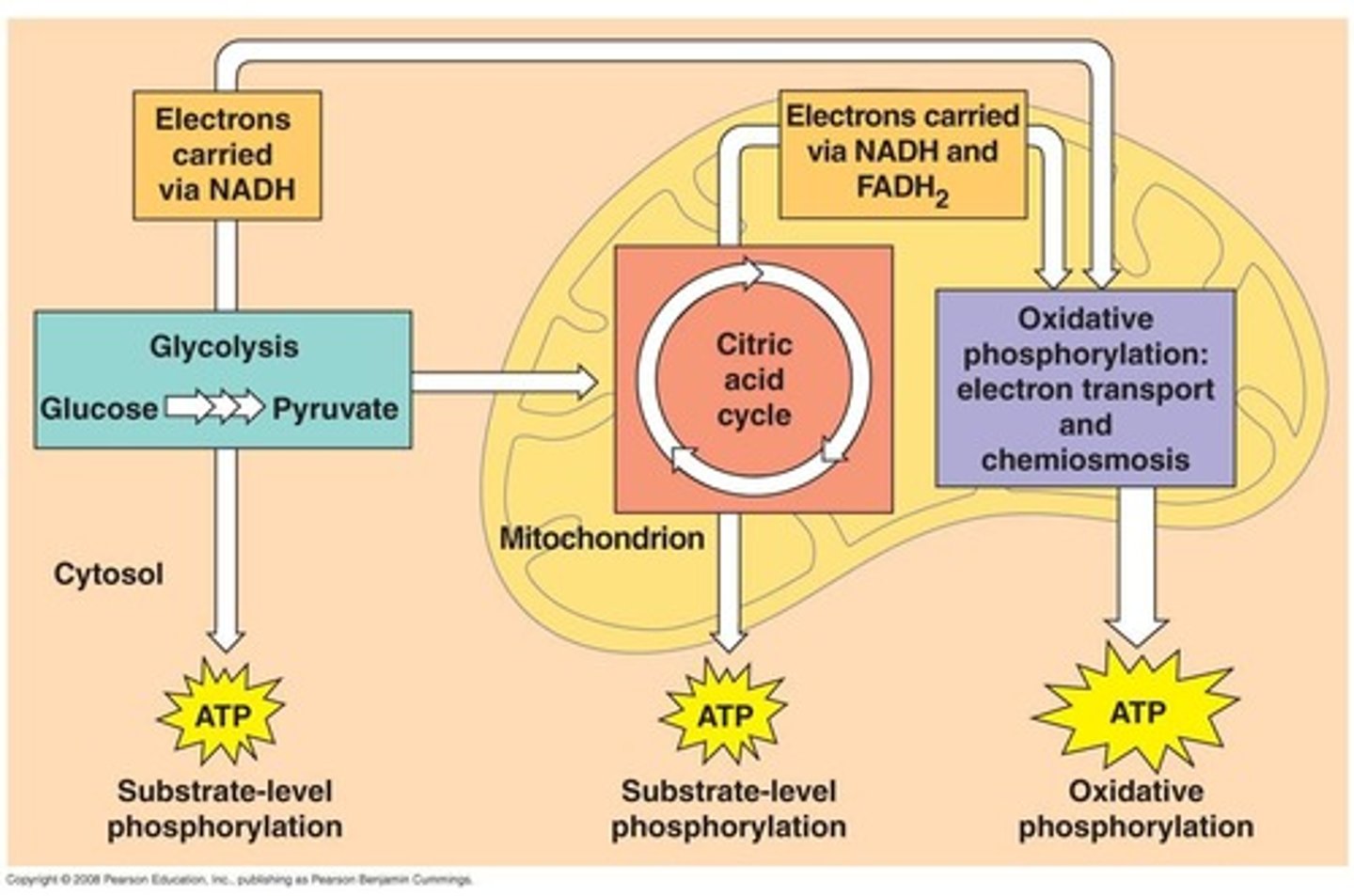
What is the net ATP produced in each step of cellular respiration and where does each step occur in the cell?
(1) Glycolysis
(2) Krebs Cycle
(3) ETC
Glycolysis produces a net of 2 ATP molecules and occurs in the cytoplasm of the cell.
Krebs Cycle produces a net of 2 ATP and occurs in the outer lumen of the mitochondria.
Electron Transport Chain (ETC) produces a net of about 34 ATP and occurs in the inner membrane (lumen) of the mitochondria.
Struggling to memorize the metabolic pathways (such as glycolysis and beta-oxidation)? Learn them like the back of your hand using Andrew's Metabolic Pathways Mastery Course @ https://mcatselfprep.com/course/andrews-metabolic-pathways-mastery-course/
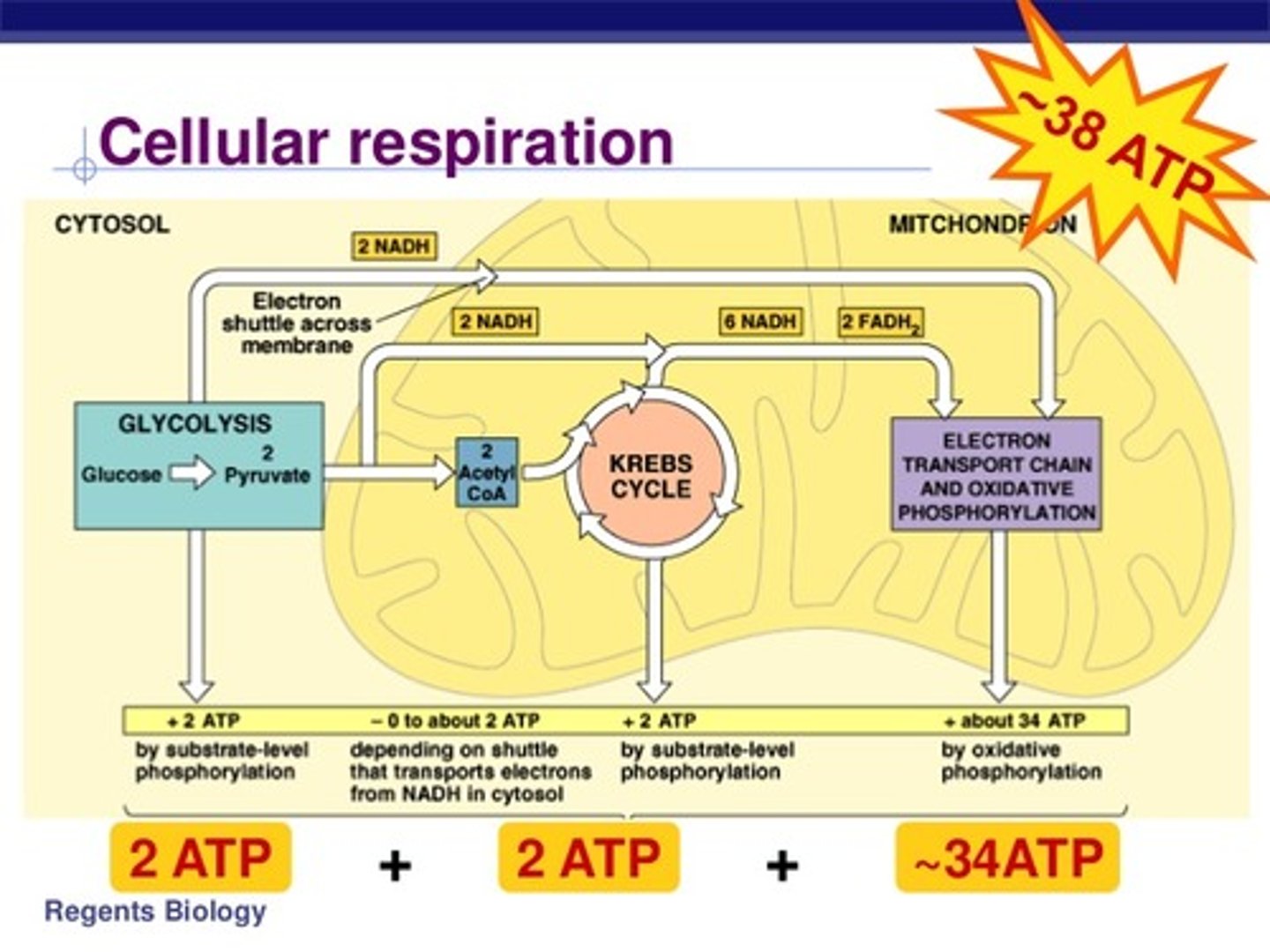
Which of the following processes are conducted during aerobic AND anaerobic respiration?
(A) Glycolysis
(B) The Linking Step
(C) Electron Transport Chain
(D) Kreb's Cycle
(A) Glycolysis
Glycolysis is conducted during aerobic respiration and anaerobic respiration. The linking step (pyruvate dehydrogenase (PDH) step), Kreb's cycle and electron transport chain are only conducted during aerobic respiration when O2 is available.
Struggling to memorize the metabolic pathways (such as glycolysis and beta-oxidation)? Learn them like the back of your hand using Andrew's Metabolic Pathways Mastery Course @ https://mcatselfprep.com/course/andrews-metabolic-pathways-mastery-course/
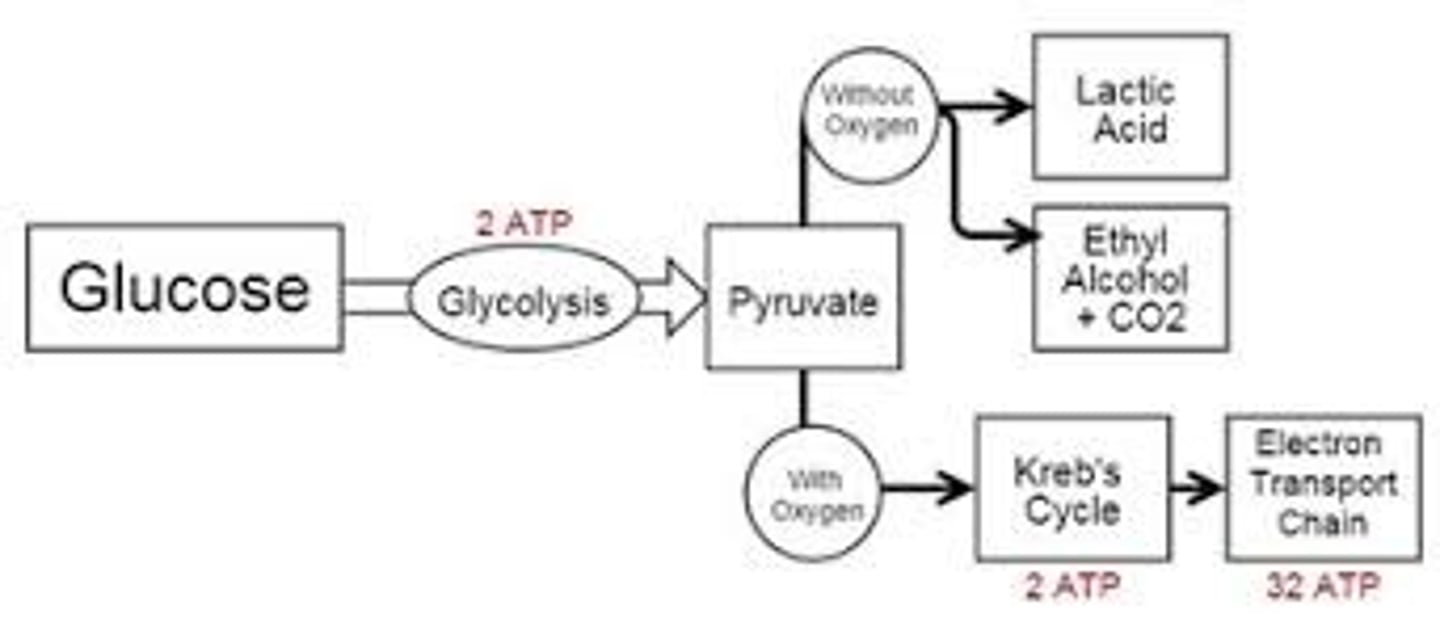
CRB True or false? There are very few diseases related to partial Glycolytic Enzyme defects and no diseases related to eliminating Glycolysis completely, because the body would not be able to live in those conditions.
True. There are very few diseases related to partial Glycolytic Enzyme defects and no diseases related to eliminating Glycolysis completely, because the body would not be able to live in those conditions.

Which of the following is considered a waste product of cellular respiration?
(A) ATP
(B) oxygen
(C) glucose
(D) carbon dioxide
(D) carbon dioxide
During cellular respiration, carbon dioxide is given off as a waste product to the surroundings.
Struggling to memorize the metabolic pathways (such as glycolysis and beta-oxidation)? Learn them like the back of your hand using Andrew's Metabolic Pathways Mastery Course @ https://mcatselfprep.com/course/andrews-metabolic-pathways-mastery-course/

When is energy stored in ATP?
(A) When a ribose sugar is added to ATP
(B) When adenosine is removed from ATP
(C) When a phosphate group is added to ADP
(D) When a phosphate group is removed from ADP
(C) When a phosphate group is added to ADP
Energy is stored when a third phosphate group is added to transform ADP into ATP.
Struggling to memorize the metabolic pathways (such as glycolysis and beta-oxidation)? Learn them like the back of your hand using Andrew's Metabolic Pathways Mastery Course @ https://mcatselfprep.com/course/andrews-metabolic-pathways-mastery-course/
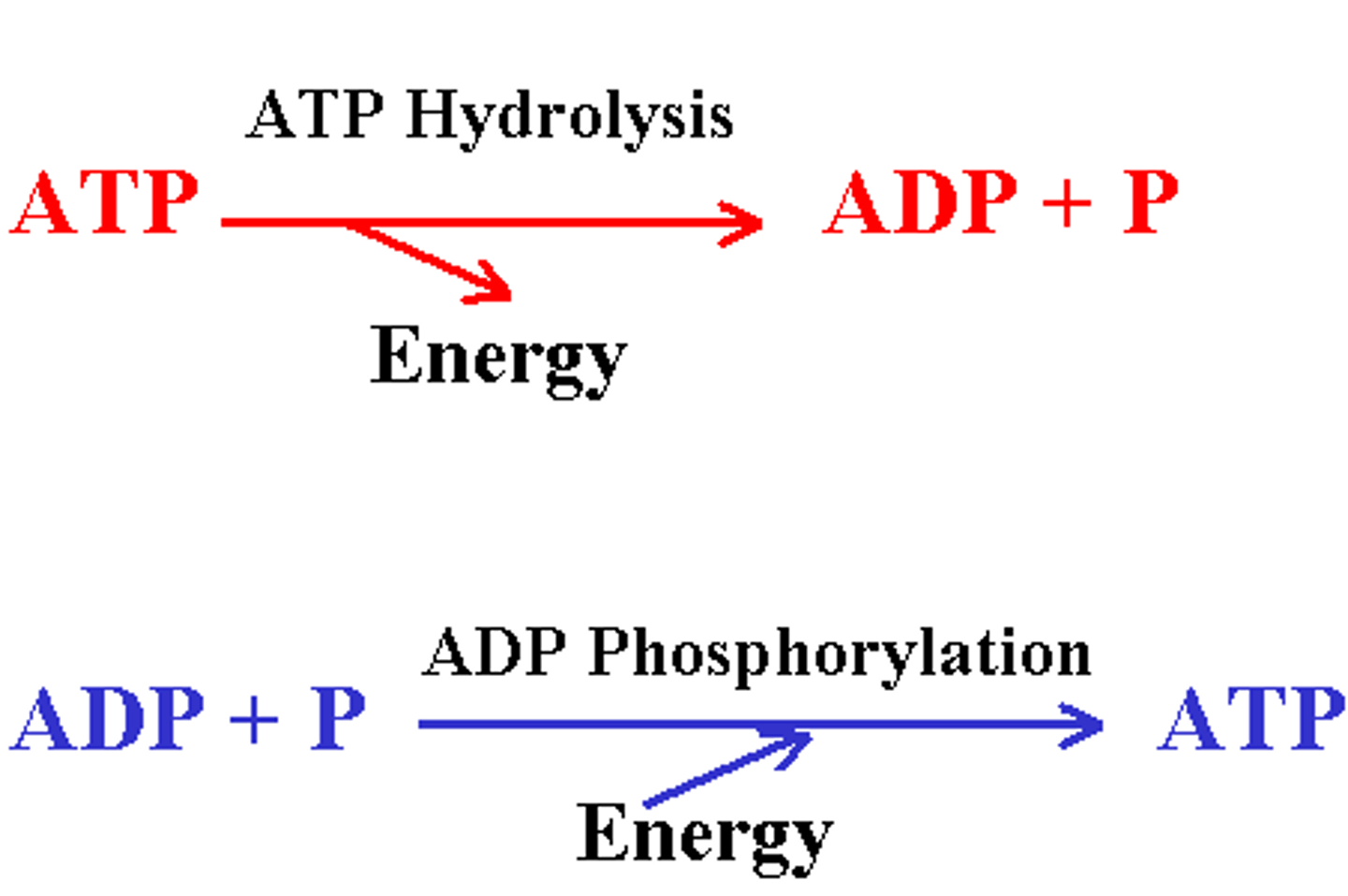
Glycolysis is the first process involved in cellular respiration. It entails the breakdown of glucose into two molecules of:
(A) fructose
(B) pyruvate
(C) acetate
(D) oxaloacetate
(B) pyruvate
Glycolysis is the first process involved in cellular respiration. It entails the breakdown of glucose into two molecules of pyruvate.
Struggling to memorize the metabolic pathways (such as glycolysis and beta-oxidation)? Learn them like the back of your hand using Andrew's Metabolic Pathways Mastery Course @ https://mcatselfprep.com/course/andrews-metabolic-pathways-mastery-course/

Anaerobic respiration in humans results in the production of _____________ while in anaerobic respiration in yeast (known as fermentation) results in the production of ____________.
(A) lactic acid, ethanol
(B) lactic acid, ethane
(C) ethanol, lactic acid
(D) ethane, lactic acid
(A) lactic acid, ethanol
Anaerobic respiration in humans results in the production of lactic acid while in anaerobic respiration in yeast (known as fermentation) results in the production of ethanol (an alcohol).
Struggling to memorize the metabolic pathways (such as glycolysis and beta-oxidation)? Learn them like the back of your hand using Andrew's Metabolic Pathways Mastery Course @ https://mcatselfprep.com/course/andrews-metabolic-pathways-mastery-course/
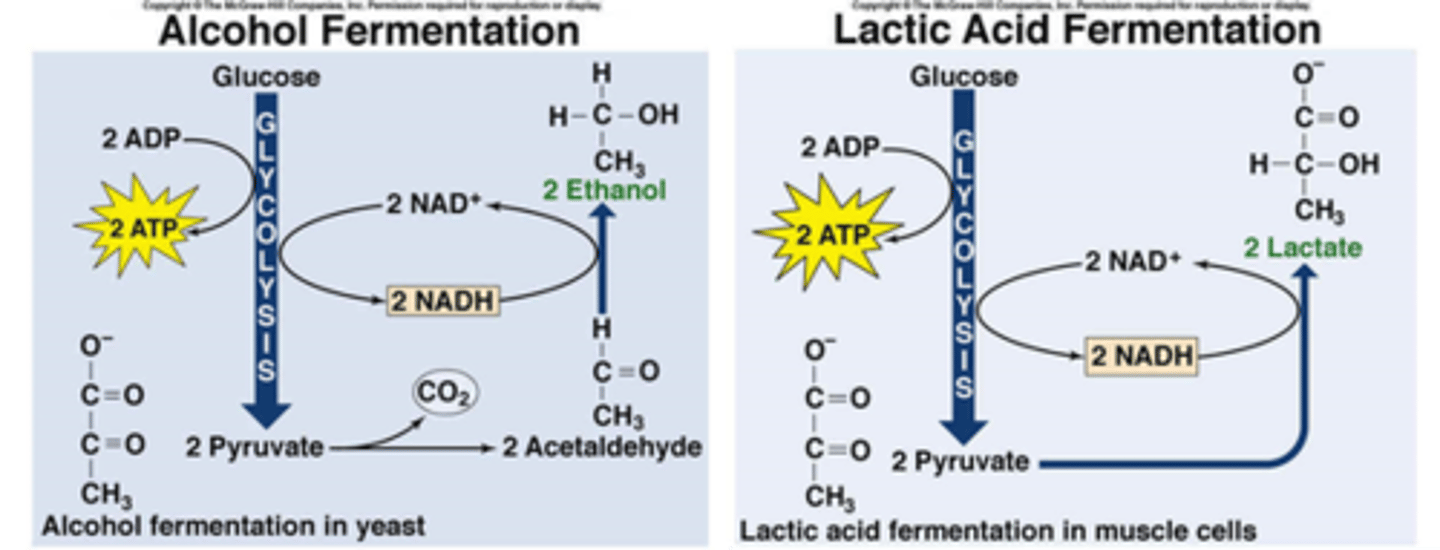
In humans, under anaerobic conditions, pyruvate will ultimately be converted into lactate. Under aerobic conditions, pyruvate will ultimately be converted into:
(A) oxaloacetate
(B) citrate
(C) carbon dioxide
(D) ATP
(C) carbon dioxide
The carbons of pyruvate will ultimately make up the carbons of carbon dioxide at the end of aerobic cellular respiration.
Struggling to memorize the metabolic pathways (such as glycolysis and beta-oxidation)? Learn them like the back of your hand using Andrew's Metabolic Pathways Mastery Course @ https://mcatselfprep.com/course/andrews-metabolic-pathways-mastery-course/
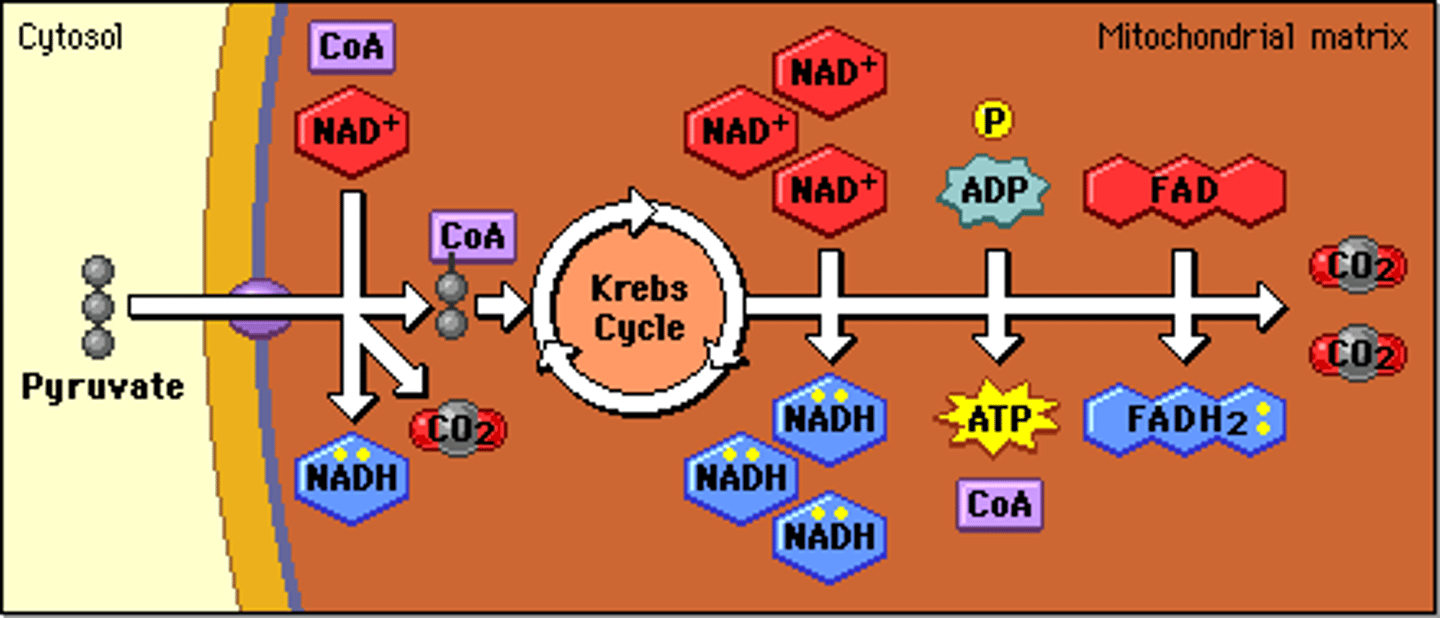
Glycolysis requires __ ATP and produces __ ATP; thus, this process yields a net total of __ ATP.
(A) 4, 6; 2
(B) 2, 6; 4
(C) 2, 4; 2
(D) 0, 4; 4
(C) 2, 4; 2
Glycolysis requires 2 ATP and produces 4 ATP; thus, this process yields a net total of 2 ATP.
Struggling to memorize the metabolic pathways (such as glycolysis and beta-oxidation)? Learn them like the back of your hand using Andrew's Metabolic Pathways Mastery Course @ https://mcatselfprep.com/course/andrews-metabolic-pathways-mastery-course/
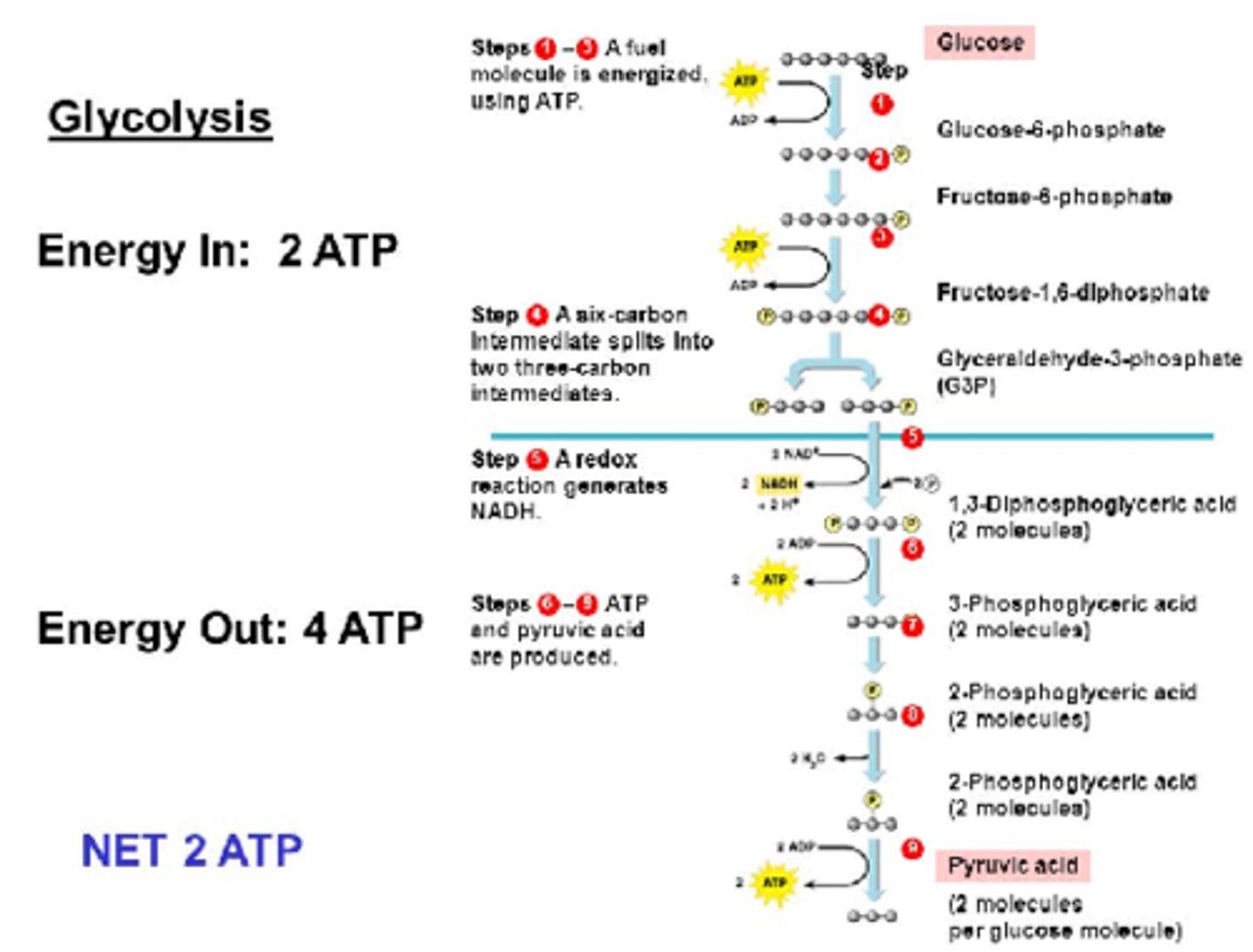
What are the end products of the "investment phase" of glycolysis? What about the "payoff phase"?
The end products of the "investment phase" are two glyceraldehyde-3-phosphate molecules. It is called the investment phase because it requires 2 ATP.
During the "payoff phase", the two glyceraldehyde-3-phosphate molecules get converted into two pyruvate molecules, producing a total of 4 ATP and 2 NADH molecules.
Struggling to memorize the metabolic pathways (such as glycolysis and beta-oxidation)? Learn them like the back of your hand using Andrew's Metabolic Pathways Mastery Course @ https://mcatselfprep.com/course/andrews-metabolic-pathways-mastery-course/
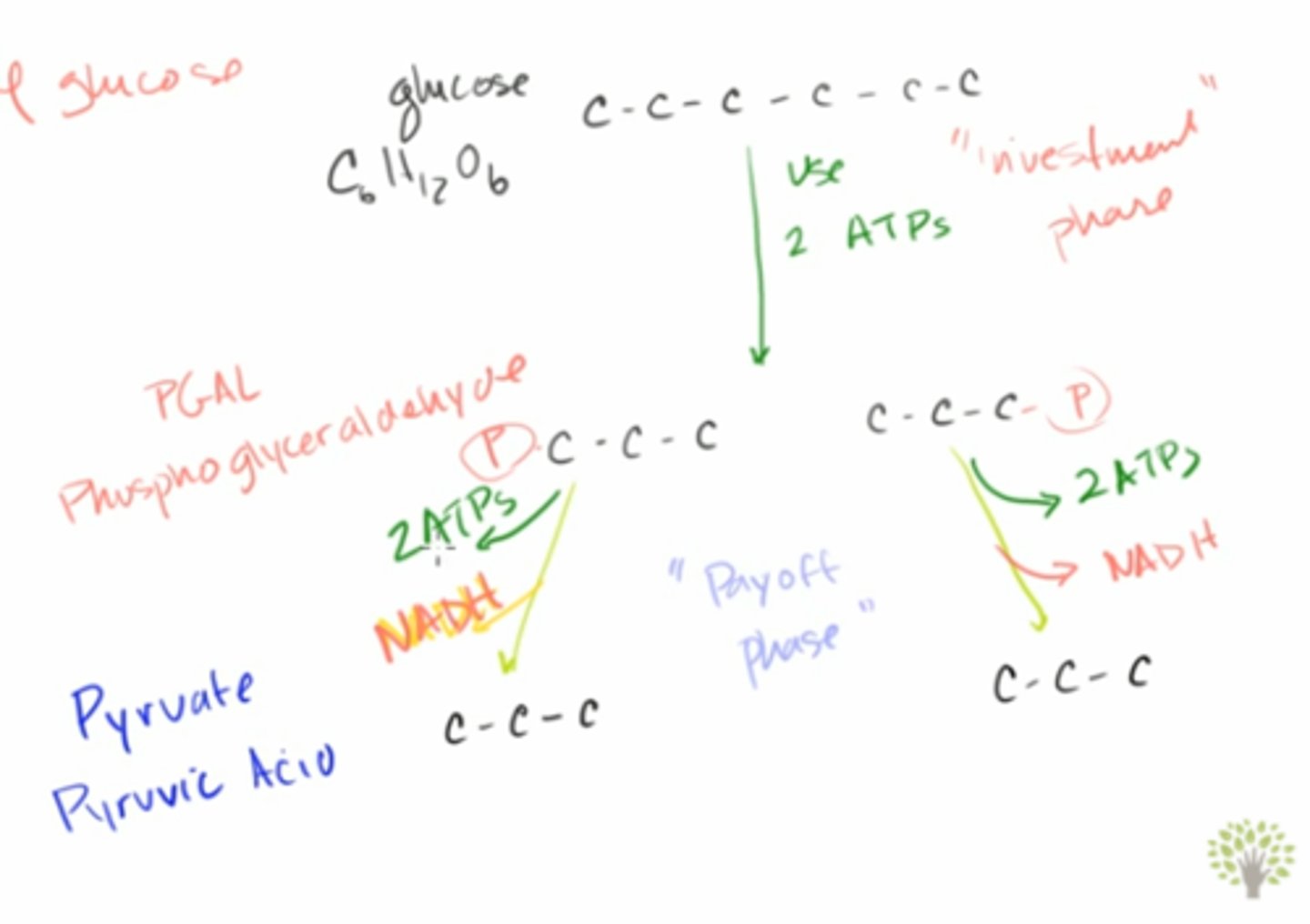
Draw out all the steps of glycolysis, including all the enzymes, substrates, and energy substrates.
It is absolutely necessary to be able to do this for the MCAT. And because it is so challenging to memorize all of this point blank, we've created our Metabolic Pathways Mastery Course: https://mcatselfprep.com/course/andrews-metabolic-pathways-mastery-course/
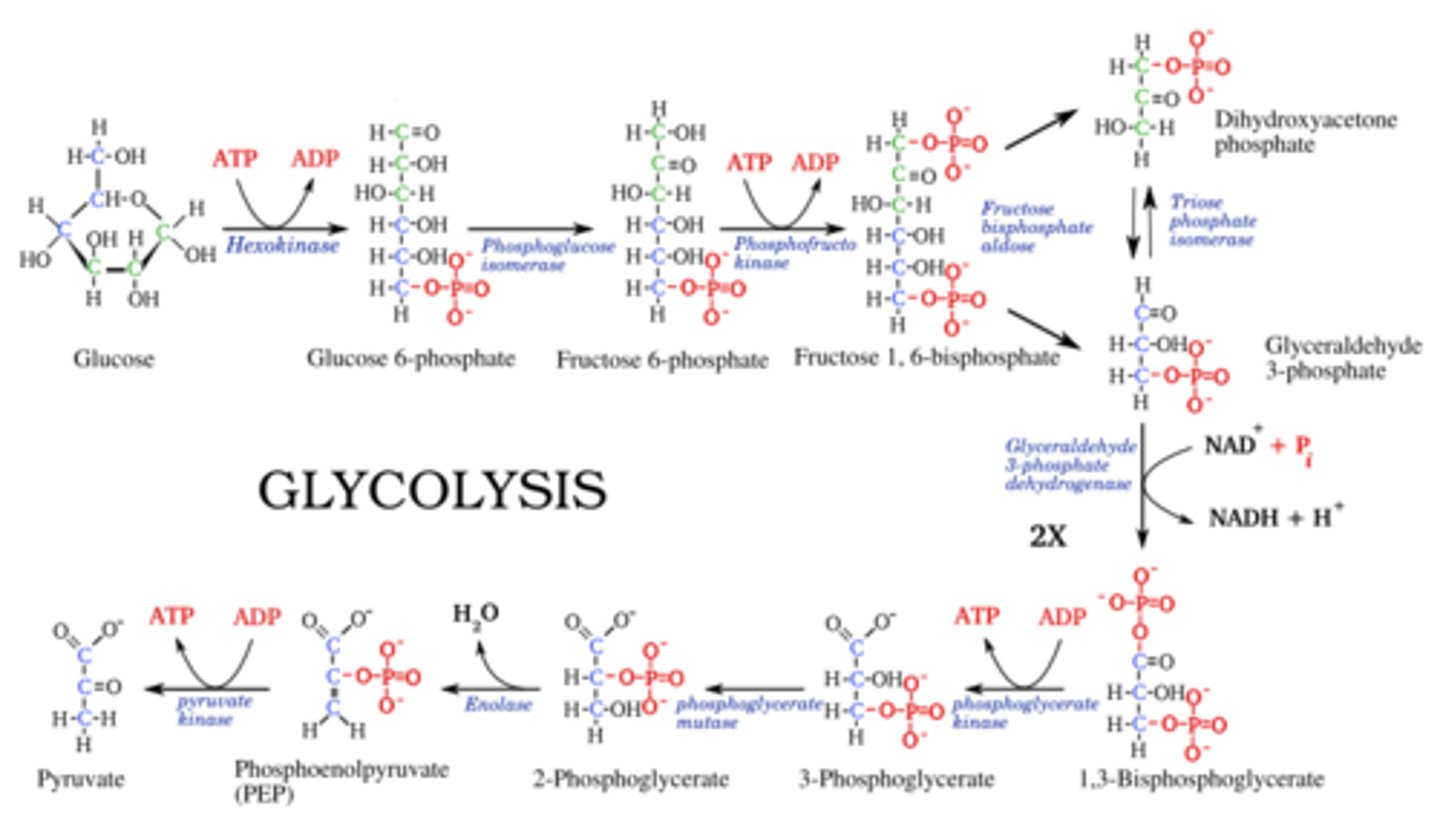
CRB Compare the reactions catalyzed by Hexokinase and Glucokinase. Where are each located?
Hexokinase and Glucokinase actually catalyze the same reaction: Phosphorylating Glucose as it enters the cell to make it Glucose-6-Phosphate.
Hexokinase is found in most tissues, and is not responsive to Insulin.
Glucokinase is in the liver cells and the pancreas' β-cells, and can be induced by insulin.
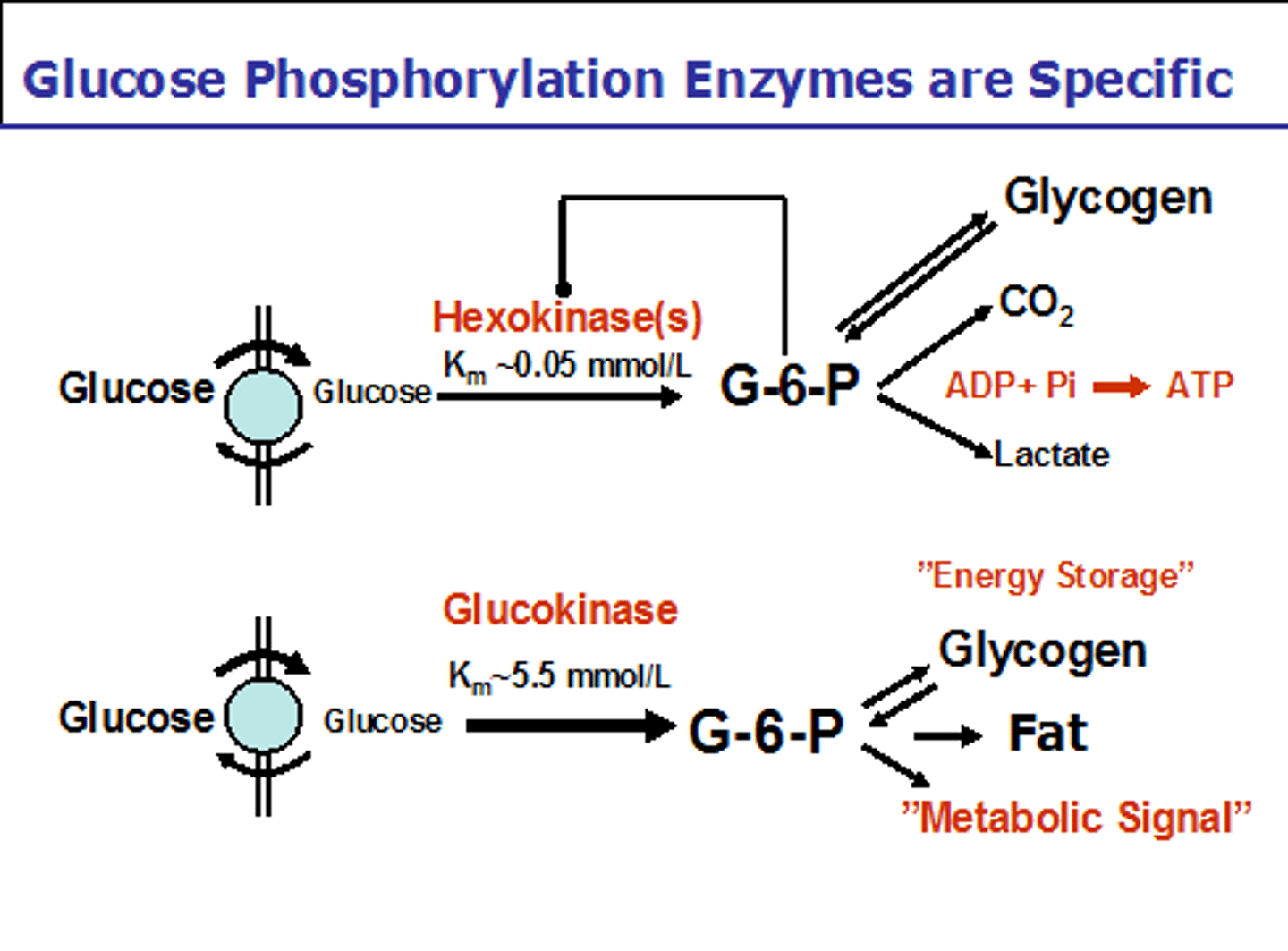
CRB Which of the following is the correct comparison of the Km of Hexokinase and Glucokinase?
(A) Km (Hexokinase) > Km (Glucokinase)
(B) Km (Hexokinase) = Km (Glucokinase)
(C) Km (Hexokinase) < Km (Glucokinase)
(D) It depends on environmental factors.
(C) Km (Hexokinase) < Km (Glucokinase)
Glucokinase has a high Km, so less glucose will be trapped/stored in cells with Glucokinase.
Hexokinase has a low Km, meaning it will trap/store glucose as Glucose-6-Phosphate even when glucose is at lower concentrations.
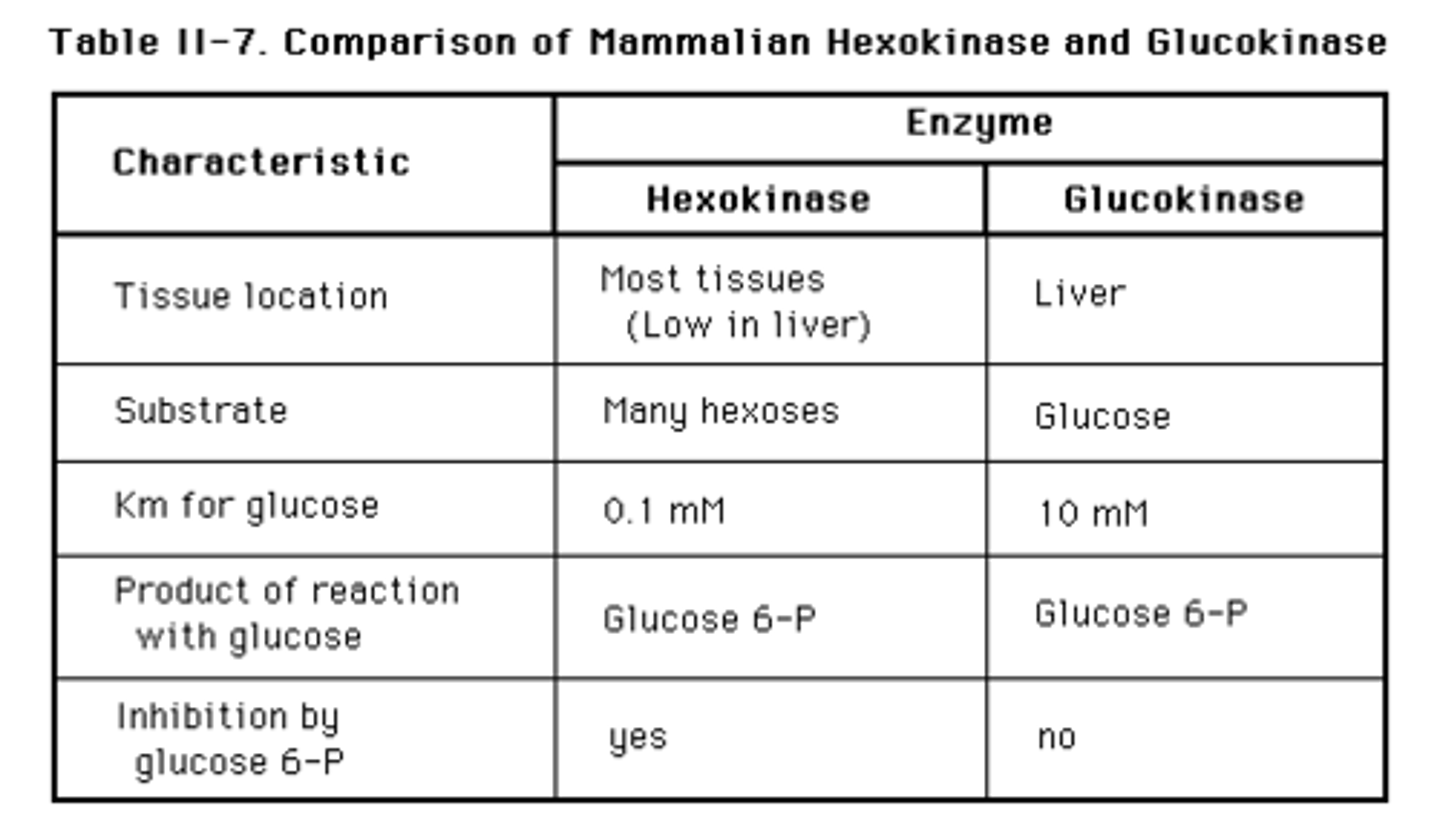
CRB Fill in the blanks: Phosphofructokinases (PFKs) are mainly responsible for regulating Glycolysis. PFK-______ would phosphorylate Fructose-6-Phosphate to Fructose-1,6-Bisphosphate using ATP. PFK-_______ would convert some Fructose-6-Phosphate to Fructose-2,6-Bisphosphate, which activates the first PFK enzyme(s) mentioned.
(A) 1 and 2, 3
(B) 1, 2 and 3
(C) 2 , 1
(D) 1 , 2
(D) 1 , 2
Phosphofructokinases (PFKs) are mainly responsible for regulating Glycolysis. PFK-1 would phosphorylate Fructose-6-Phosphate to Fructose-1,6-Bisphosphate using ATP. PFK-2 would convert some Fructose-6-Phosphate to Fructose-2,6-Bisphosphate, which activates the first PFK enzyme(s) mentioned.
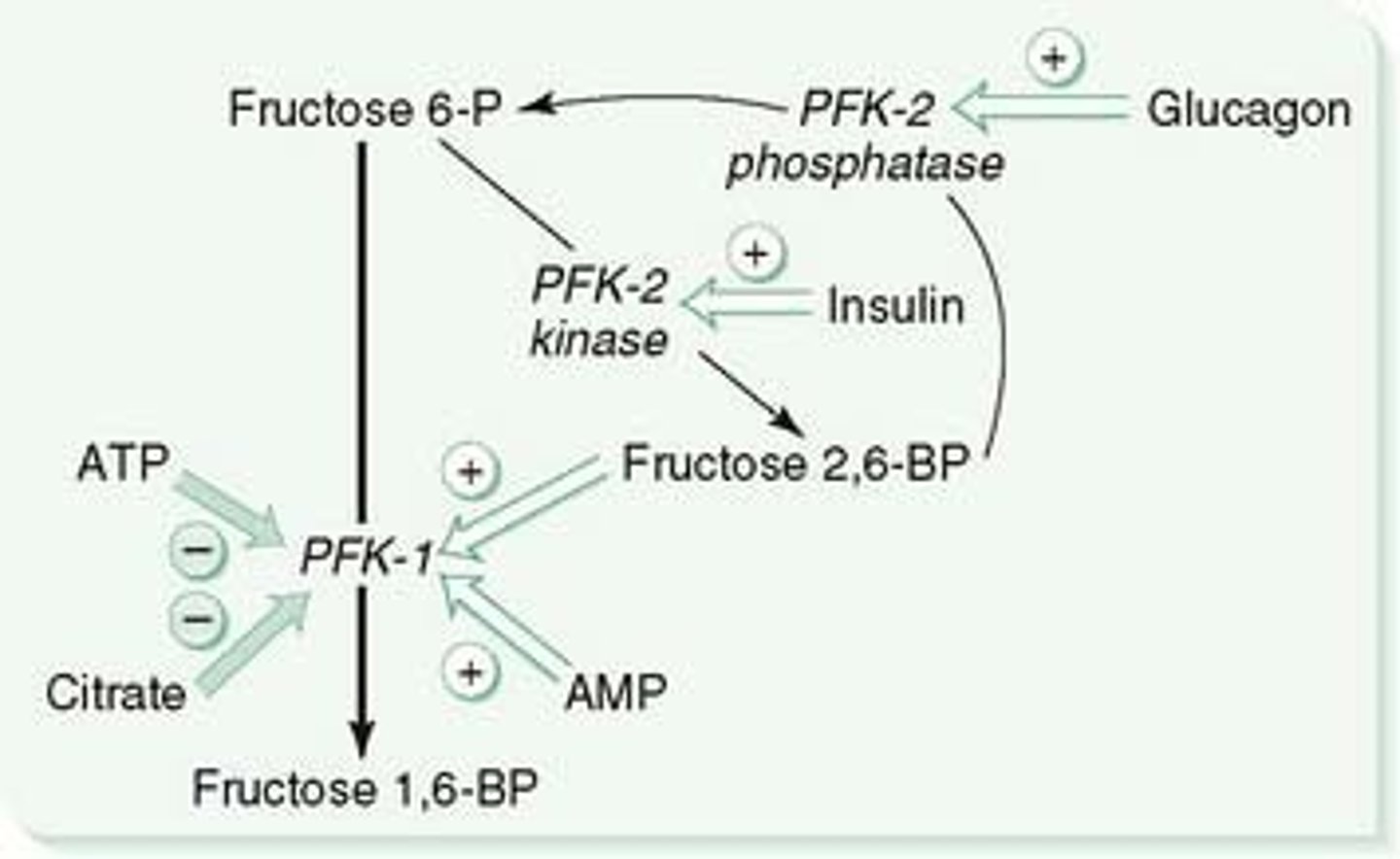
CRB Which of the following do NOT directly inhibit or stimulate PFK-1 or PFK-2?
(A) ATP
(B) Glucose
(C) Citrate
(D) AMP
(B) Glucose
ATP, AMP and Citrate all can directly regulate PFK-1 or PFK-2.
Insulin can stimulate PFK-2, but glucose itself does not directly regulate these enzymes.
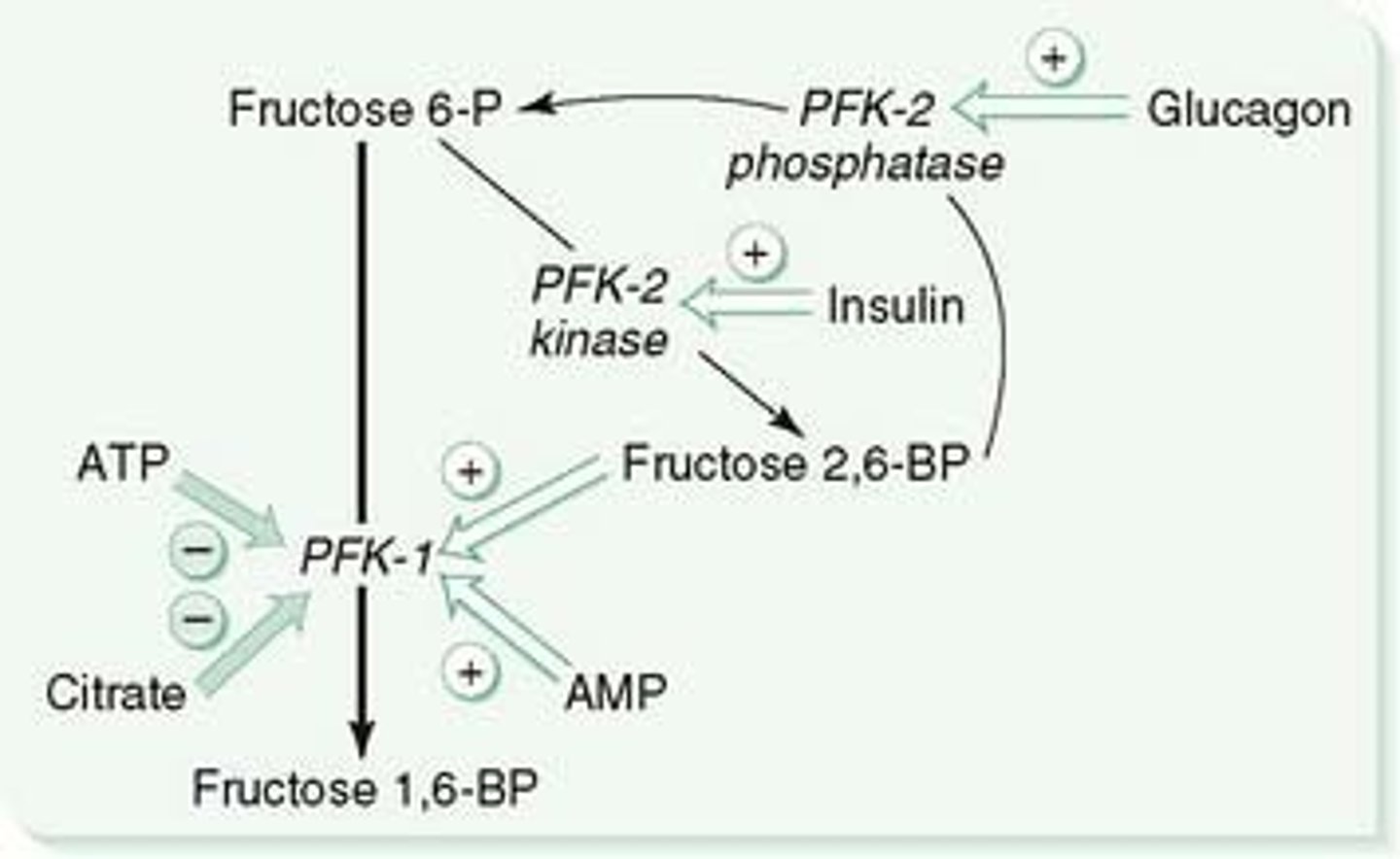
CRB Classify each of the following molecules as either activating or inhibitng PFK-enzymes.
I. Citrate
II. ATP
III. AMP
IV. F2,6BP
Inhibiting PFK Enzymes:
I. Citrate
II. ATP
Activating PFK Enzymes
III. AMP
IV. F2,6BP
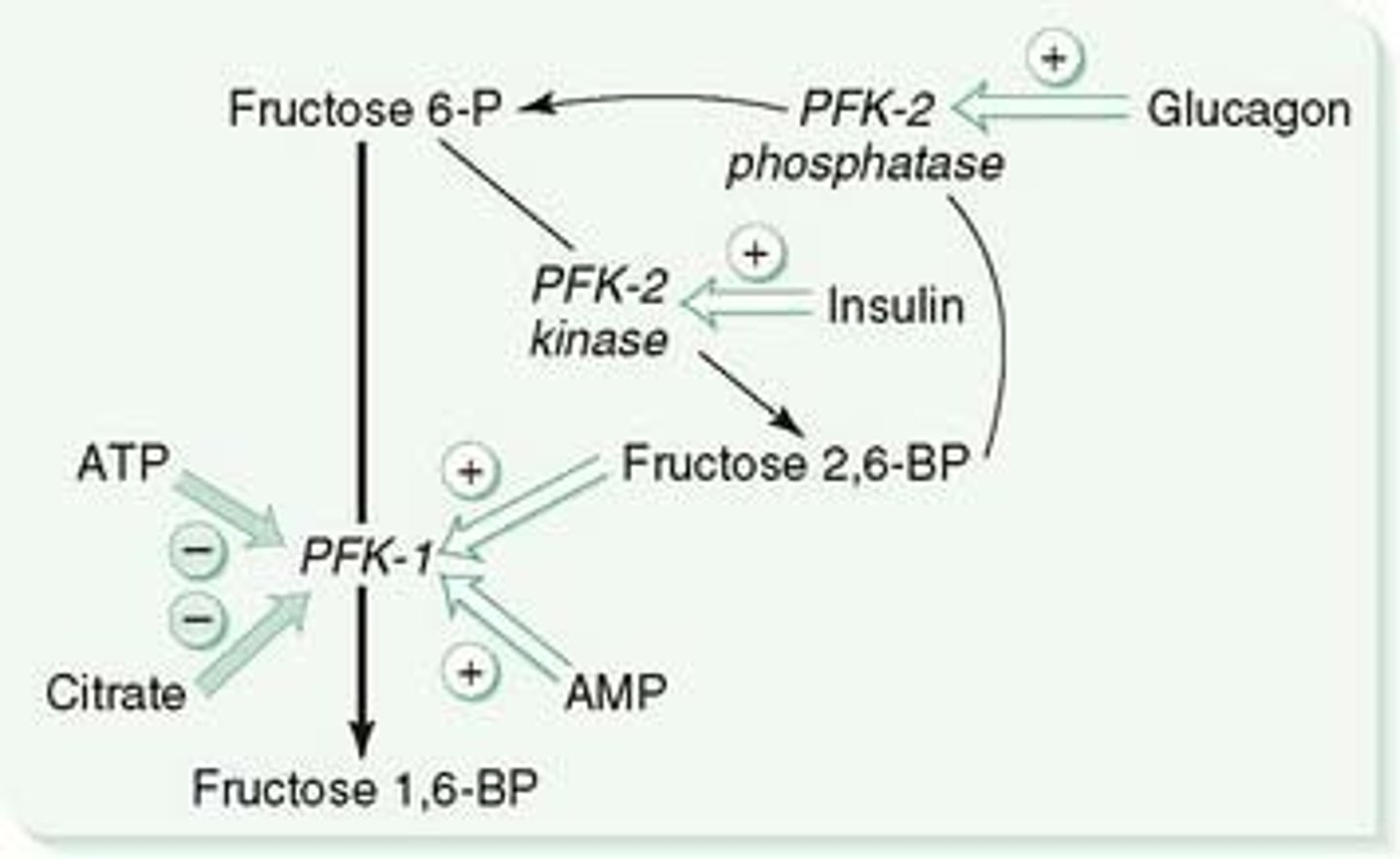
CRB Which of the following important Glycolytic enzymes is responsible for the only Oxidation-Reduction Reaction in Glycolysis, producing 1,3BPG and NADH?
(A) PFK-1
(C) 3-Phosphoglycerate Kinase [3-PGK]
(C) Pyruvate Kinase
(D) Glyceraldehyde-3-Phosphate Dehydrogenase [GAP-DH]
(D) Glyceraldehyde-3-Phosphate Dehydrogenase [GAP-DH]
Glyceraldehyde-3-Phosphate Dehydrogenase is responsible for the only Oxidation-Reduction Reaction in Glycolysis, producing 1,3BPG and NADH.
![<p>(D) Glyceraldehyde-3-Phosphate Dehydrogenase [GAP-DH]</p><p>Glyceraldehyde-3-Phosphate Dehydrogenase is responsible for the only Oxidation-Reduction Reaction in Glycolysis, producing 1,3BPG and NADH.</p>](https://knowt-user-attachments.s3.amazonaws.com/29a28b78-5606-4873-824b-4e8ad70a84a5.jpg)
CRB Which important Glycolytic Enzyme is upregulated by Fructose-1,6-Bisphosphate, linking the rate of this reaction to the actions of PFK-1, coordinating how quickly Glycolysis goes?
(A) PFK-2
(C) 3-Phosphoglycerate Kinase [3-PGK]
(C) Pyruvate Kinase
(D) Glyceraldehyde-3-Phosphate Dehydrogenase [GAP-DH]
(C) Pyruvate Kinase
Pyruvate Kinase is upregulated by Fructose-1,6-Bisphosphate, linking the rate of this reaction to the actions of PFK-1, coordinating how quickly Glycolysis goes.
I often like to think of F-1,6-BP as the chain connecting the bike wheels of PFK-1 and Pyruvate Kinase, keeping both wheels spinning at the same rate.

CRB True or false? 3-Phosphoglycerate Kinase [3-PGK] catalyzes a Substrate Phosphorylation reaction, producing ATP that can be used by the cell.
True. 3-Phosphoglycerate Kinase [3-PGK] catalyzes a Substrate Phosphorylation reaction, producing ATP that can be used by the cell.
![<p>True. 3-Phosphoglycerate Kinase [3-PGK] catalyzes a Substrate Phosphorylation reaction, producing ATP that can be used by the cell.</p>](https://knowt-user-attachments.s3.amazonaws.com/9bf4a3d5-f05d-4bf5-9979-9a8f10f16b3a.png)
During the fasted state, which of the following mechanisms does the body utilize to maintain its blood glucose level?
I. Glycogenolysis
II. Glycolysis
III. Gluconeogenesis
(A) II only
(B) I and II only
(C) I and III only
(D) I, II and III
(C) I and III only
In a fasted state, blood glucose levels are maintained through glycogenolysis (the breakdown of glycogen) and gluconeogenesis (the formation of glucose).
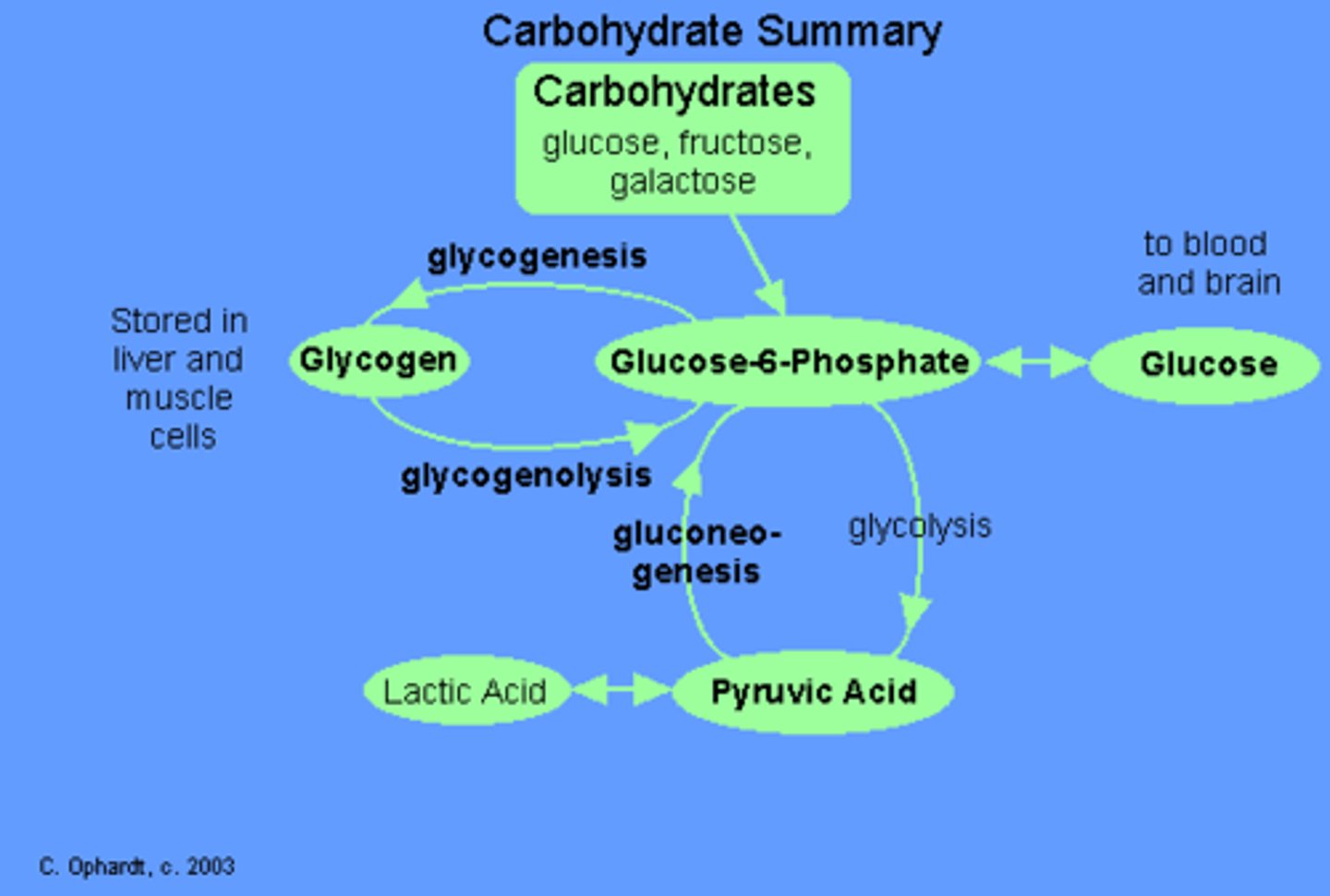
CRB Before you can breakdown glycogen in Glycogenolysis, you have to create Glycogen. Which of the following statements about Glycogenesis is FALSE?
(A) Glucose-1-Phosphate is used to synthesize glycogen.
(B) Glucose needs to be activated by coupling to UTP.
(C) Glycogen Synthase is the rate-limiting enzyme and forms α-1,4-glycosidic bonds.
(D) A separate branching enzyme must be used to form the α-1,6-glycosidic bonds at branch points.
(B) Glucose needs to be activated by coupling to UTP.
UDP is used for coupling, not UTP.
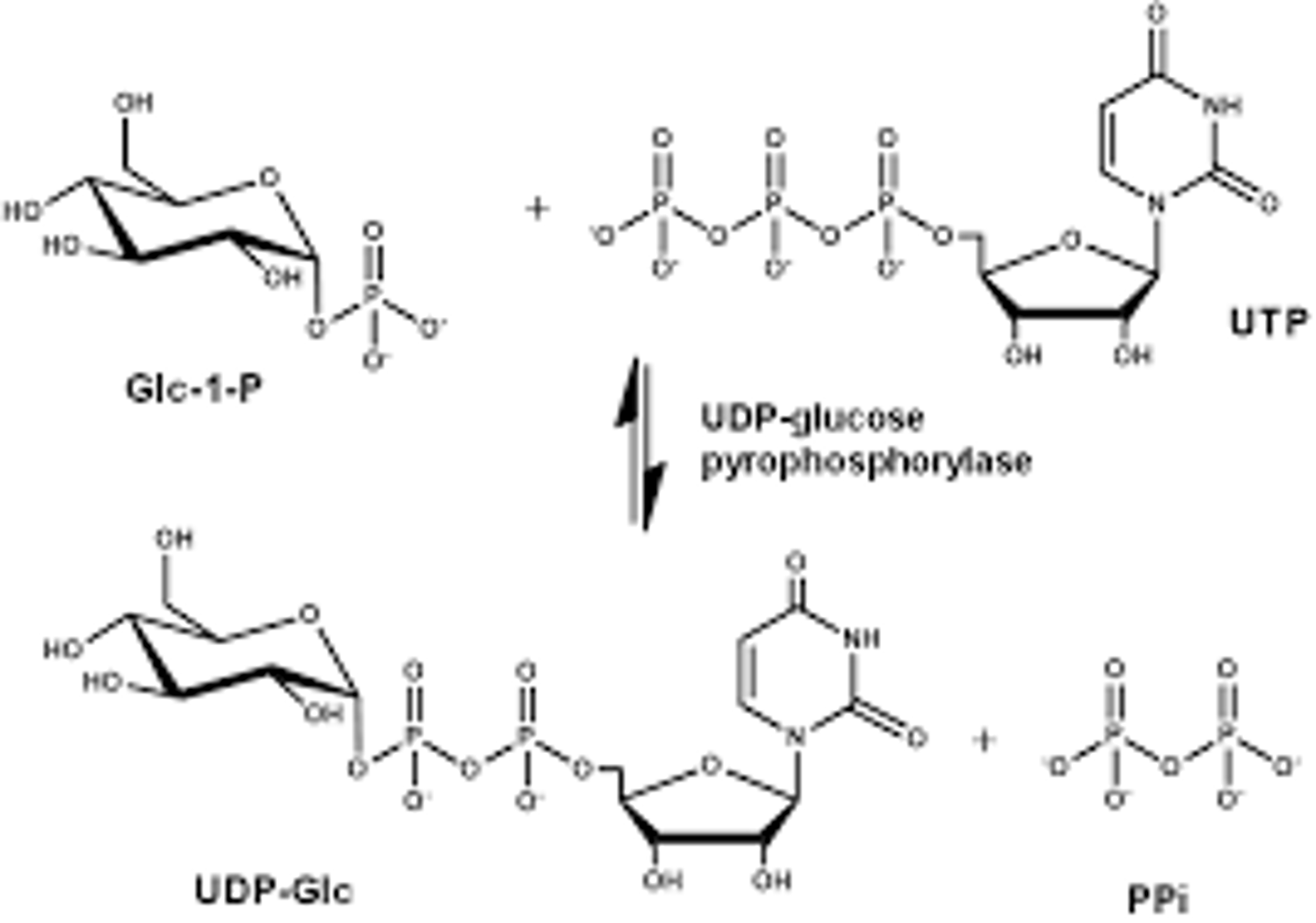
CRB True or false? A Debranching enzyme must be used to deconstruct the branching points in Glycogen, and is a two-enzyme complex.
True. A Debranching enzyme must be used to deconstruct the branching points in Glycogen, and is a two-enzyme complex.

When you first start fasting, your body will primarily rely upon ____________________, but after about 10-18 hours your body switches to primarily utilizing _____________.
(A) gluconeogenesis, gluconeogenesis
(B) gluconeogenesis, glycogenolysis
(C) glycogenolysis, glycogenolysis
(D) glycogenolysis, gluconeogenesis
(D) glycogenolysis, gluconeogenesis
When you first start fasting, your body will primarily rely upon glycogenolysis, but after about 10-18 hours your body switches to primarily utilizing gluconeogenesis.
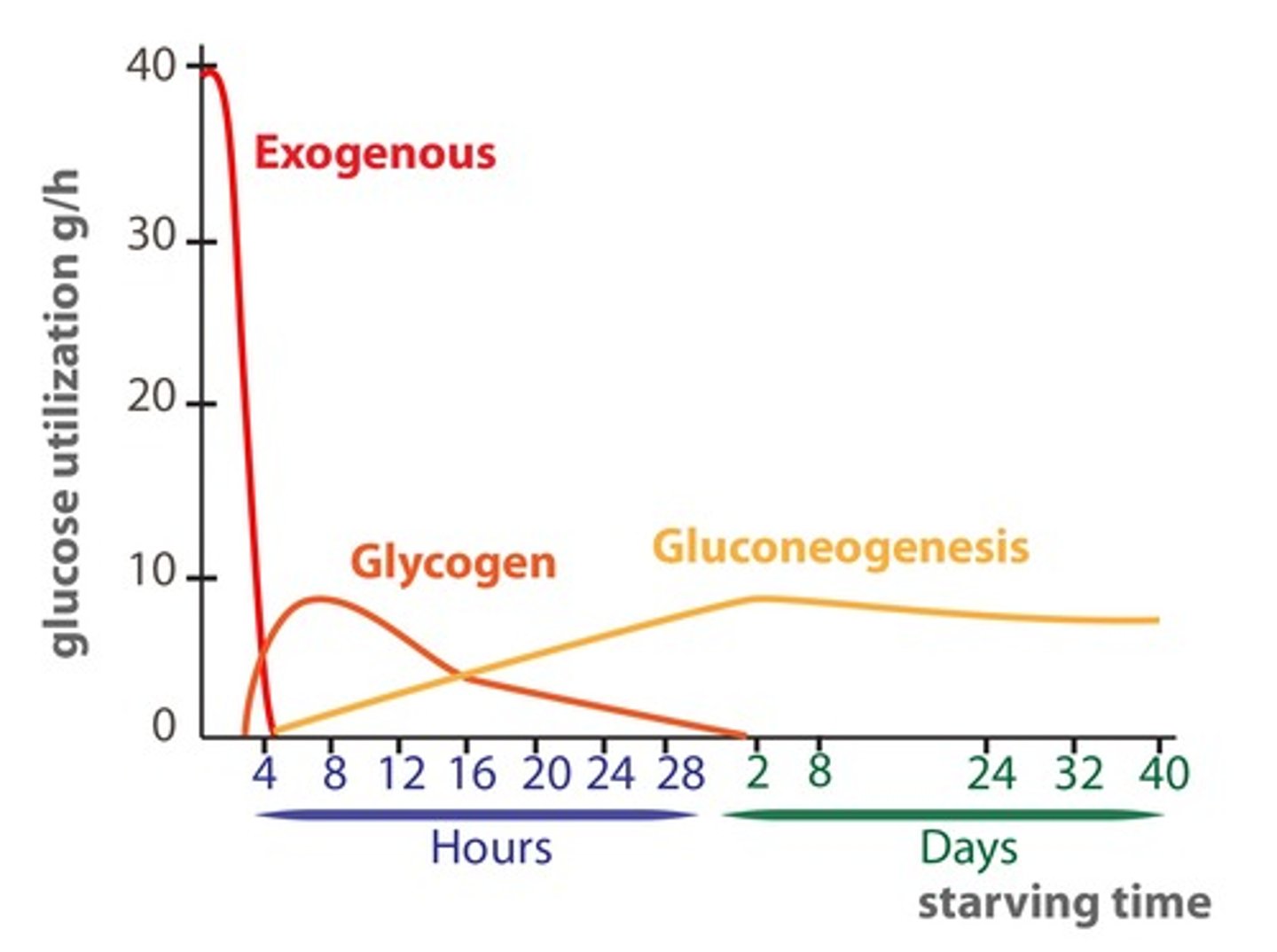
True or False? Because gluconeogenesis is just the reverse of glycolysis, the glycolysis enzymes can all be used in reverse order.
False. Although gluconeogenesis is almost exactly the reverse of glycolysis, three of glycolysis reactions are irreversible, so alternate enzymes are needed for those three steps during gluconeogenesis.

Compare the ∆G value for the reversible versus non-reversible steps of glycolysis.
The reversible steps of glycolysis have a ∆G value that is close to zero.
The irreversible steps of glycolysis on the other hand have a very large negative ∆G value. Thus, going in reverse (during gluconeogenesis) would require a huge amount of energy.
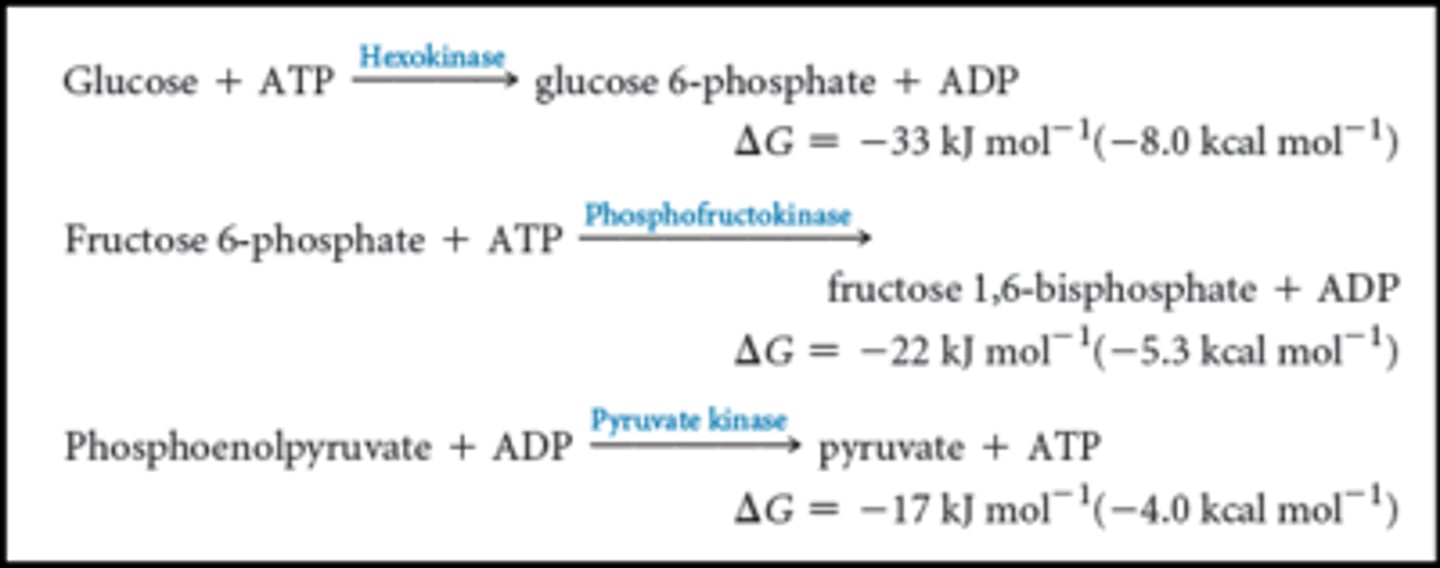
CRB A few key enzymes in Glycolysis are Irreversible, and must have different enzymes catalyze the backwards reaction in Gluconeogenesis. Which of the following is NOT one of those enzymes?
(A) PFK-1
(B) Hexokinase/Glucokinase
(C) Pyruvate Kinase
(D) GAPDH
(D) GAPDH
PFK-1, Hexokinase/Glucokinase and Pyruvate Kinase are all Irreversible Enzymes in glycolysis.

CRB Draw out each of the reactions that the following Gluconeogenic Enzymes catalyze.
- Pyruvate Carboxylase
- Phosphoenolpyruvate Carboxykinase (PEPCK)
- Fructose-1,6-Bisphosphatase
- Glucose-6-Phosphatase
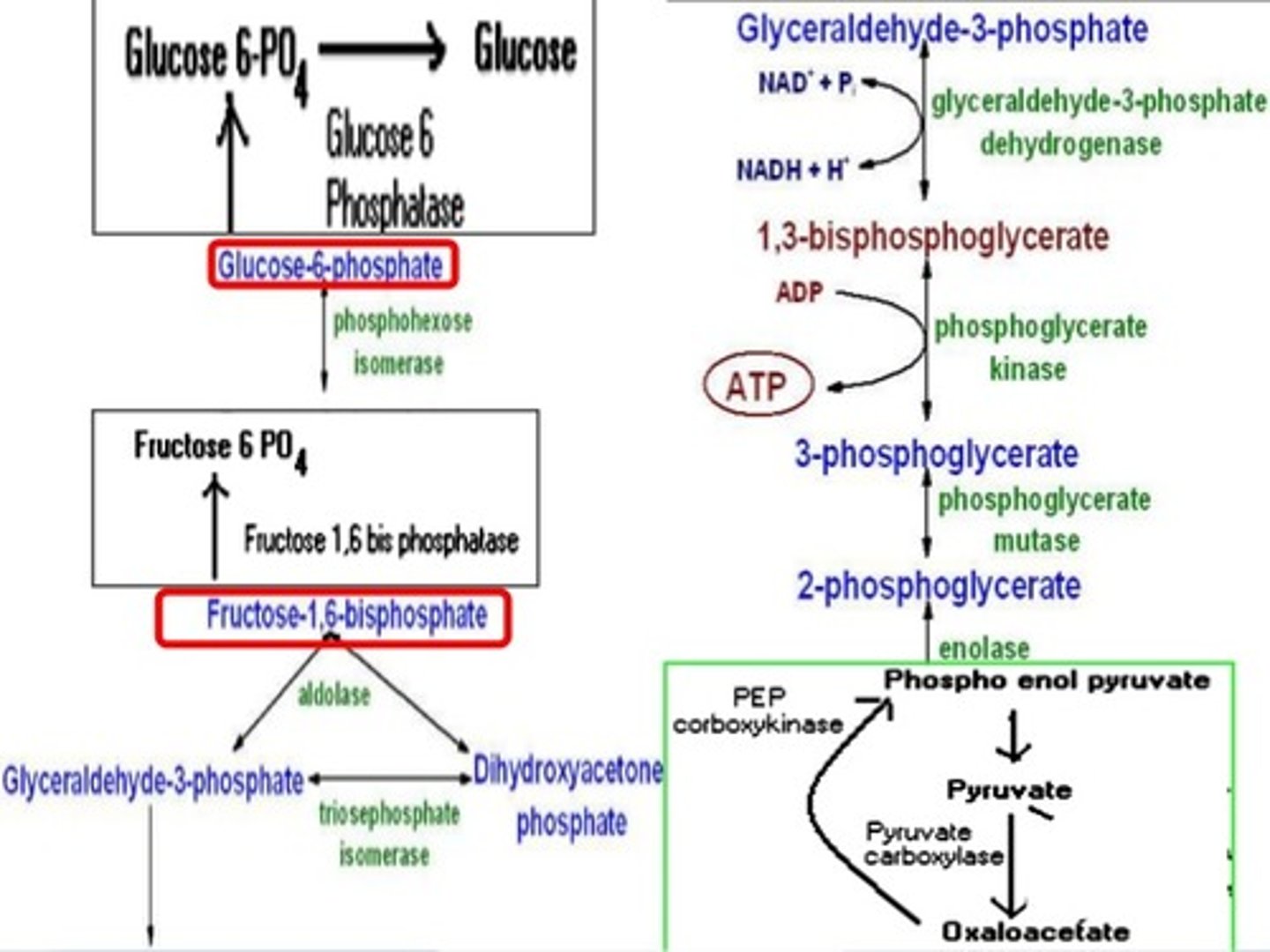
Draw the pathway for the 3 steps of gluconeogenesis that differ from glycolysis, including the enzymes, substrates, and energy substrates.
It is absolutely necessary to be able to do this for the MCAT. And because it is so challenging to memorize all of this point blank, we've created our Metabolic Pathways Mastery Course: https://mcatselfprep.com/course/andrews-metabolic-pathways-mastery-course/

CRB Which of the following intermediates can be isomerized to form Glyceraldehyde-3-Phosphate or be reduced to form Glycerol-3-Phosphate, which can give the important molecule Glycerol to be used as the backbone of Triglycerides and Phospholipid Bilayers?
(A) 1,3BPG
(B) DHAP
(C) Glucose-6-Phosphate
(D) Pyruvate
(B) DHAP
DHAP (Dihydroxyacetone Phosphate) can be isomerized to form Glyceraldehyde-3-Phosphate or reduced to form Glycerol-3-Phosphate, which can give the important molecule Glycerol to be used as the backbone of Triglycerides and Phospholipid Bilayers.
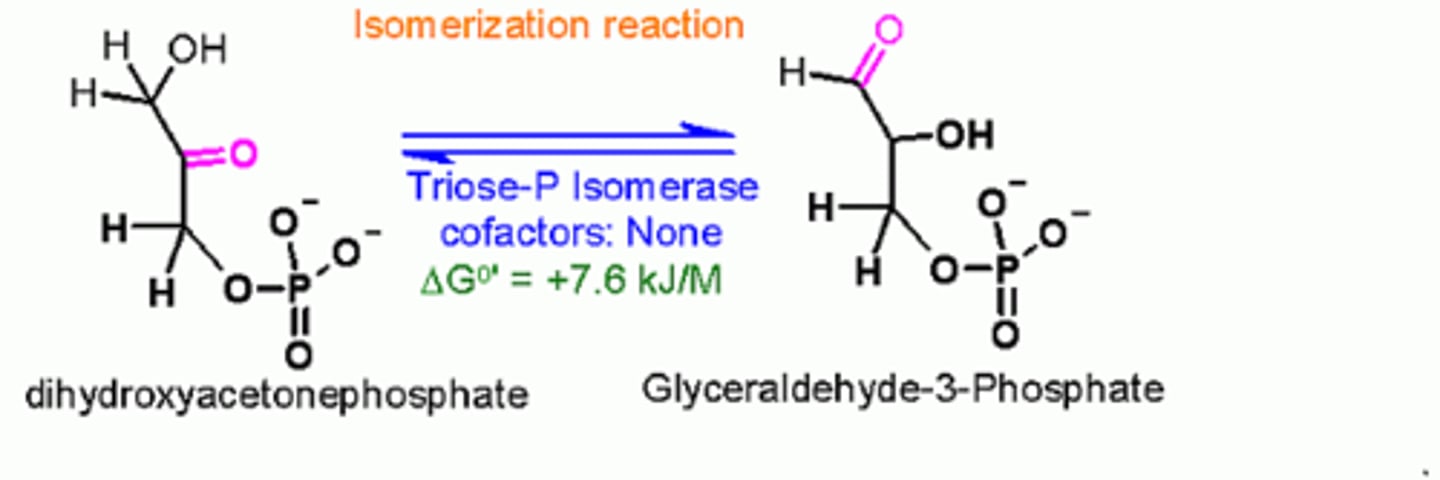
Which enzyme is absolutely essential in both glycogenolysis and gluconeogenesis?
(A) Fructose-1,6-bisphosphotase
(B) Hexokinase
(C) Glucose-6-phosphatase
(D) Glucokinase
(C) Glucose-6-phosphatase
Without glucose-6-phosphatase, neither glycogenolysis nor gluconeogenesis can produce glucose that can be used to raise blood glucose levels. For this reason, people who lack this enzyme suffer from extreme hypoglycemia.
Struggling to memorize the metabolic pathways (such as glycolysis and beta-oxidation)? Learn them like the back of your hand using Andrew's Metabolic Pathways Mastery Course @ https://mcatselfprep.com/course/andrews-metabolic-pathways-mastery-course/
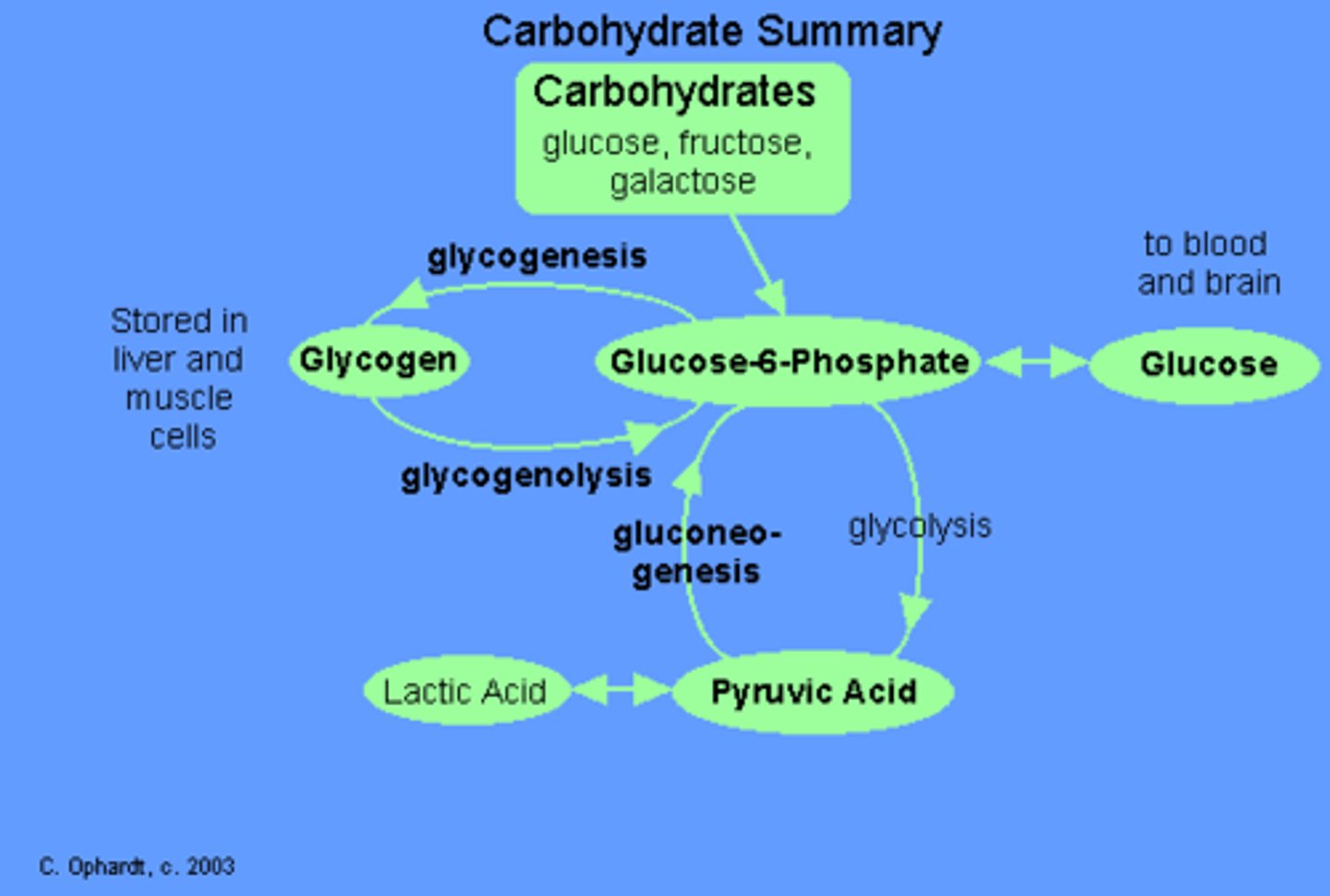
CRB Recall that Red Blood Cells do not have mitochondria inside of them. How might this be helpful when transporting Oxygen?
(A) It can maximize how much of the Red Blood Cell's Volume is devoted to Hemoglobin .
(B) It can prevent Red Blood Cells from using the oxygen that they are supposed to carry to oxygen-depleted tissues.
(C) Both A and B
(D) Neither A nor B
(C) Both A and B
Each of the following are reasons Red Blood Cells do not have mitochondria:
(A) It can maximize how much of the Red Blood Cell's Volume is devoted to Hemoglobin .
(B) It can prevent Red Blood Cells from using the oxygen that they are supposed to carry to oxygen-depleted tissues.

According to Le Chatlier's principle, if the concentration of glucose increased within a cell, what would happen to the rate of glycolysis and gluconeogenesis?
If the concentration of glucose increased within a cell, the rate of glycolysis would increase and the rate of gluconeogenesis would decrease.
Struggling to memorize the metabolic pathways (such as glycolysis and beta-oxidation)? Learn them like the back of your hand using Andrew's Metabolic Pathways Mastery Course @ https://mcatselfprep.com/course/andrews-metabolic-pathways-mastery-course/

According to Le Chatlier's principle, if the concentration of oxaloacetate increased within a cell, what would happen to the rate of glycolysis and gluconeogenesis?
If the concentration of oxaloacetate increased within a cell, the rate of glycolysis would decrease and the rate of gluconeogenesis would increase.
Struggling to memorize the metabolic pathways (such as glycolysis and beta-oxidation)? Learn them like the back of your hand using Andrew's Metabolic Pathways Mastery Course @ https://mcatselfprep.com/course/andrews-metabolic-pathways-mastery-course/
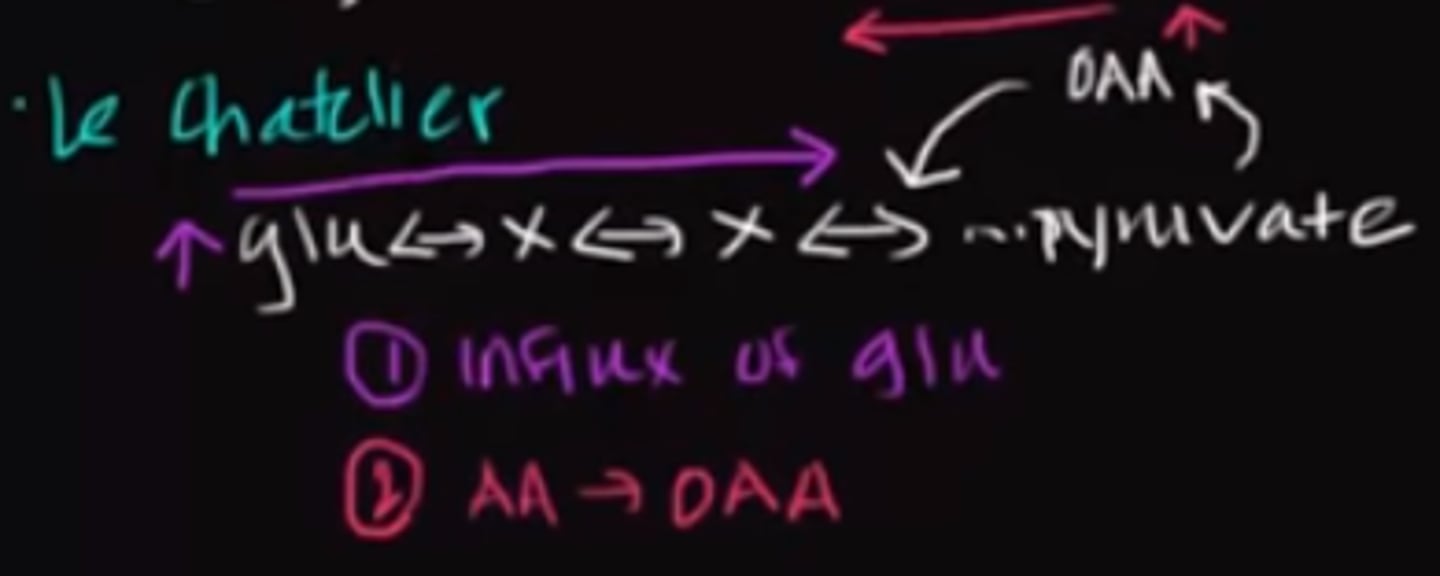
If the concentration of ATP increased within a cell, what would happen to the rate of glycolysis and gluconeogenesis? Why?
If the concentration of ATP increased within a cell, the rate of glycolysis would decrease and the rate of gluconeogenesis would increase. This is because ATP is an allosteric inhibitor of some of the enzymes involved in glycolysis and an allosteric activator of some of the enzymes involved in gluconeogenesis.
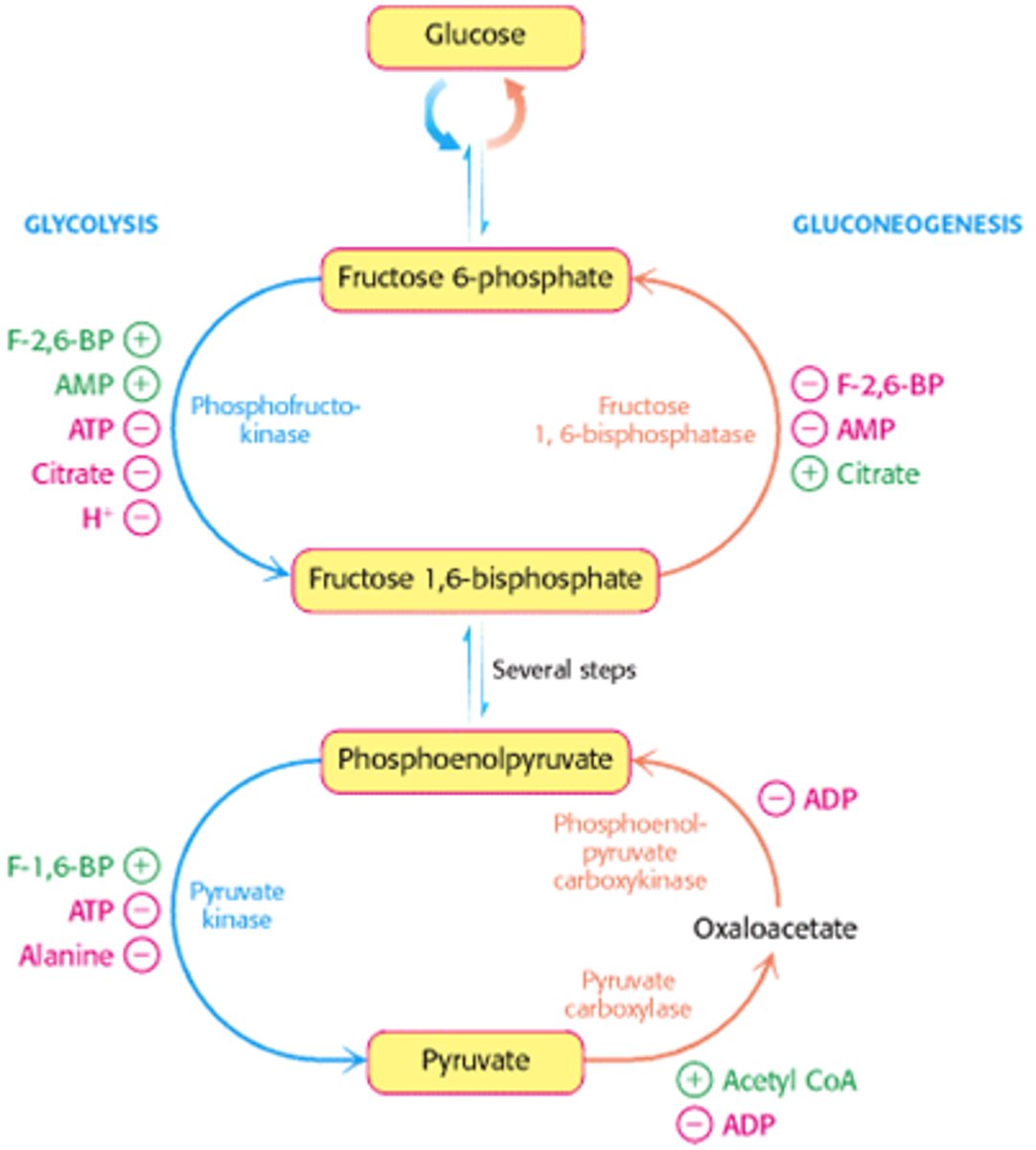
If the concentration of AMP increased within a cell, what would happen to the rate of glycolysis and gluconeogenesis? Why?
If the concentration of AMP increased within a cell, the rate of glycolysis would increase and the rate of gluconeogenesis would decrease. This is because AMP is an allosteric activator of some of the enzymes involved in glycolysis and an allosteric inhibitor of some of the enzymes involved in gluconeogenesis.
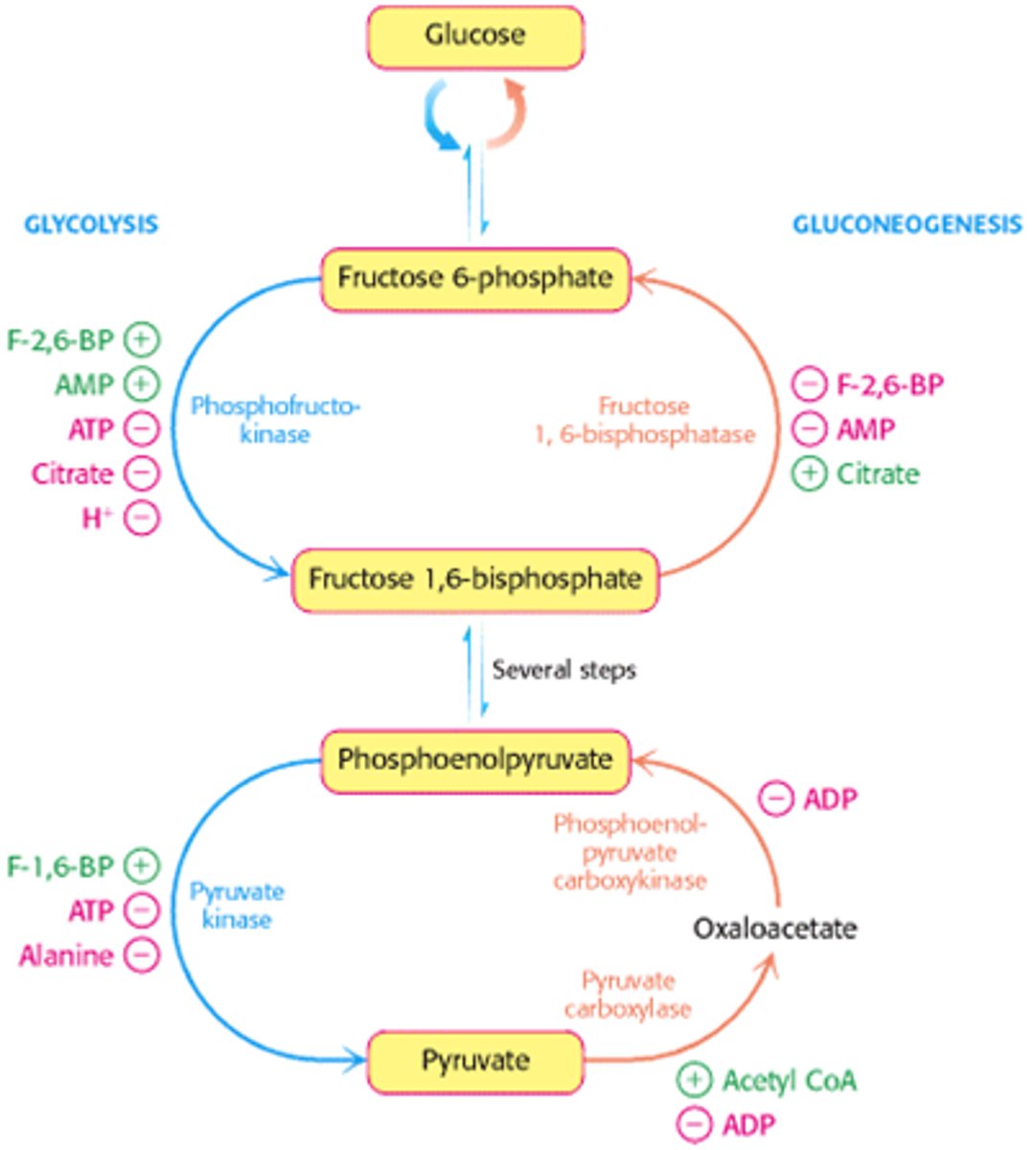
How might transcription be altered in order to increase the rate of glycolysis in the cell?
Transcription factors could activate genes that code for enzymes involved in glycolysis. Once the gene is transcribed, the mRNA can be used to translate the proteins and enzymes necessary for glycolysis. With increased concentrations of these enzymes, the rate of glycolysis will increase.
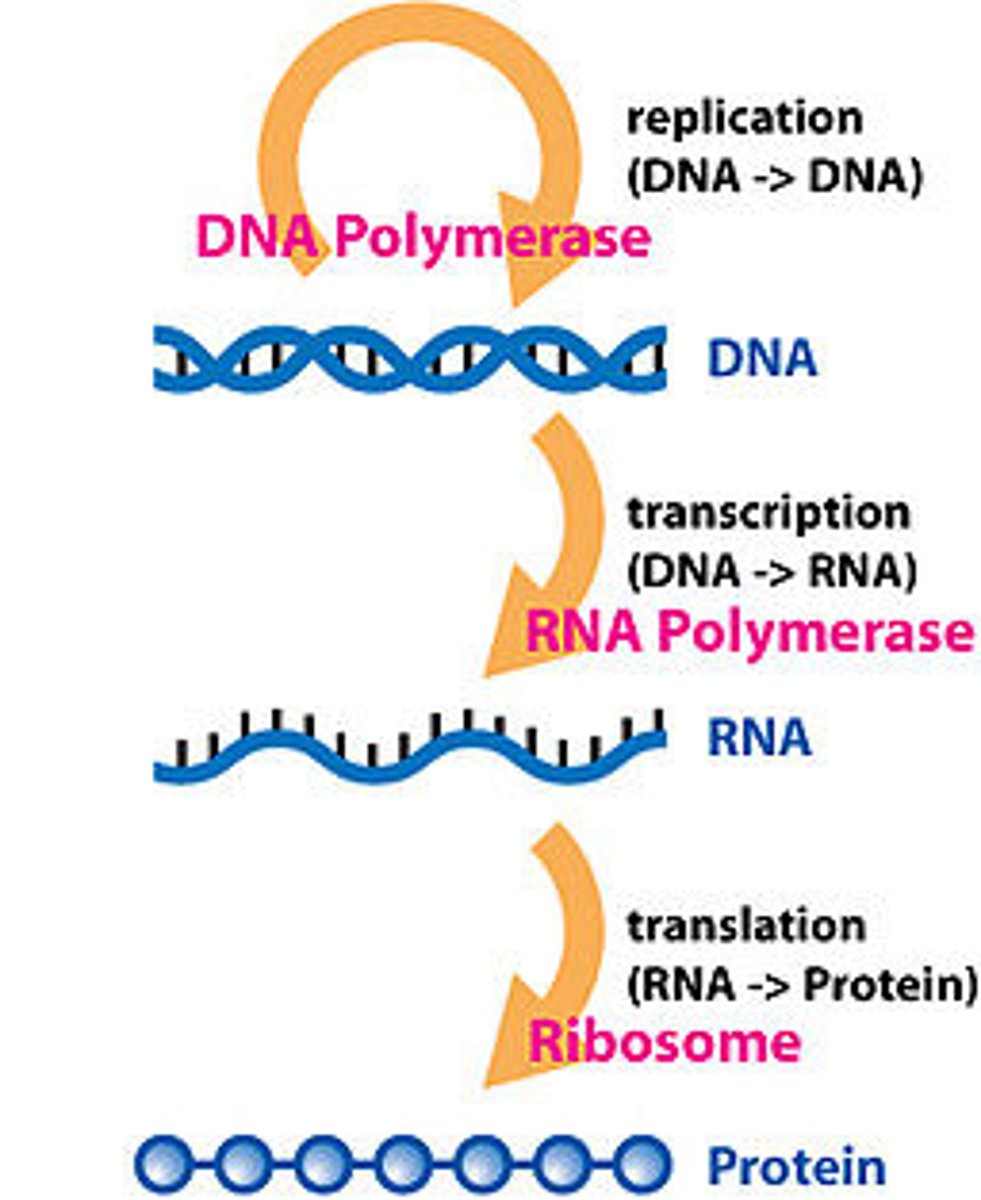
Which of the following forms of regulation are effective in regulating metabolic pathways in the short term?
I. Le Chatlier's Principle
II. Allosteric Regulation
III. Transcriptional Regulation
(A) I Only
(B) III Only
(C) I and II Only
(D) II and III Only
(C) I and II Only
Le Chatlier's principle and allosteric regulation are effective in regulating metabolic pathways in the short term while transcriptional regulation is an effective long-term mechanism.
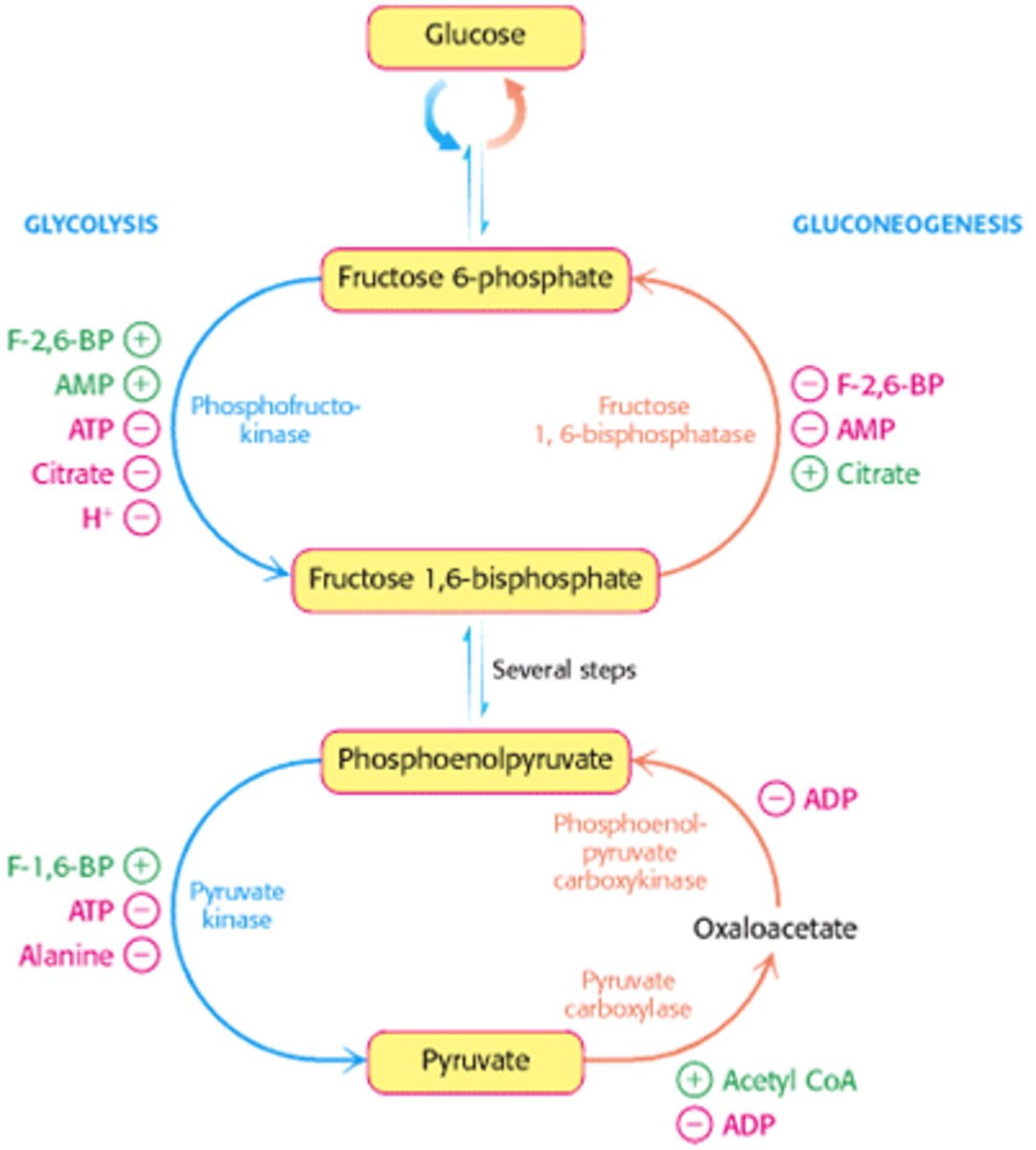
CRB Write out a table of the amino acids that are Glucogenic (can be used as intermediates in gluconeogenesis), Ketogenic (can be converted into ketone bodies), or both.
I like to remember that the two "L" amino acids are the Ketogenic-only ones!
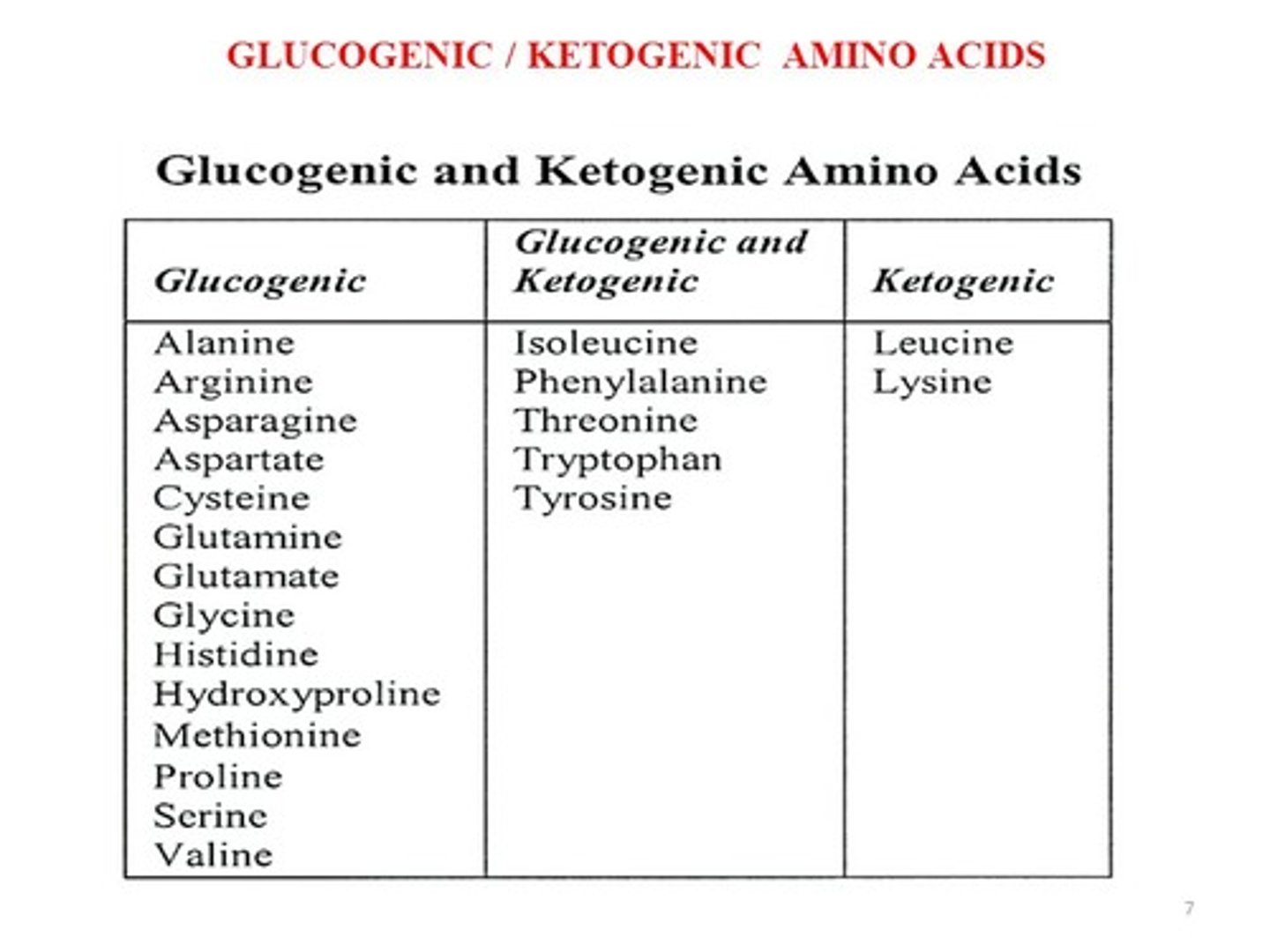
When someone has hyperglycemia, their body will produce insulin or glucagon? Why?
When someone has hypoglycemia, their body will produce insulin or glucagon? Why?
When someone has hyperglycemia, their body will produce insulin since insulin promotes the storage of glucose via pathways such as glycogenesis.
When someone has hypoglycemia, their body will produce glucagon since glucagon activates pathways such as gluconeogenesis and glycogenolysis that will increase one's blood glucose levels.

CRB Which of the following statements about Glycogen Storage Diseases are true?
I. Isoforms of key enzymes in Glycogenesis or Glycogenolysis are the main cause.
II. These isoforms lead to too much glucose buildup, or make it not easily broken down.
III. These Glycogen Storage Diseases are characterized by a lack of glycogen in all tissues.
(A) I only
(B) III only
(C) I and II only
(D) I and III only
(A) I only
Each of the following statements about Glycogen Storage Diseases are true:
I. Isoforms of key enzymes in Glycogenesis or Glycogenolysis are the main cause.
III. These Glycogen Storage Diseases are characterized by a lack of glycogen in one or more tissues.

Hormones such as glucagon and insulin rely on phosphorylation to modify the activity of the metabolic pathways. Explain how this works.
Hormones such as glucagon and insulin bind to cell membrane receptors that will cause intracellular changes, ultimately resulting in the phosphorylation/dephosphorylation of enzymes involved in various metabolic pathways, either activating or inhibiting their activity.
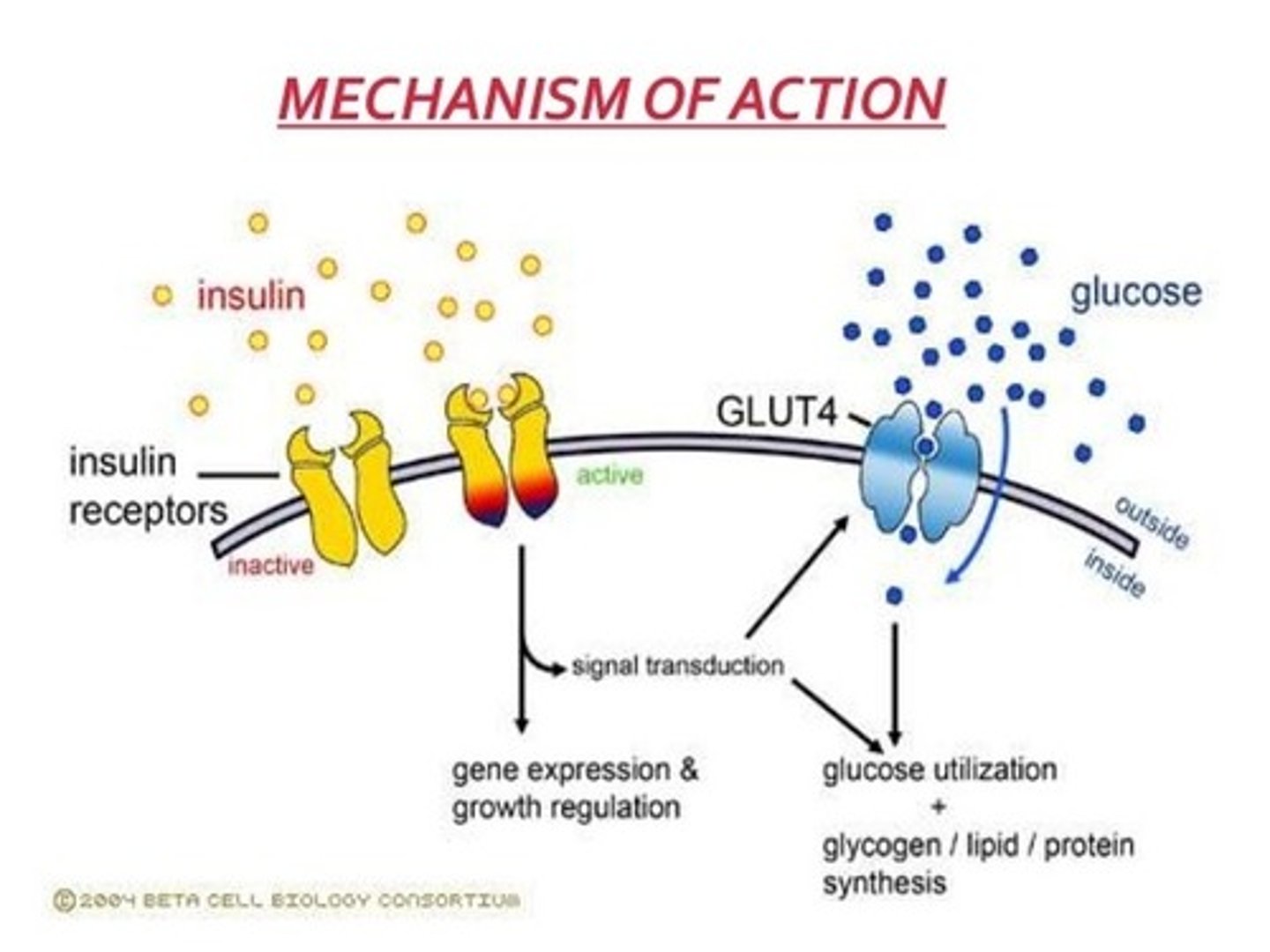
Put the following regulatory mechanisms in order from fastest-acting to slowest-acting:
I. Le Chatlier/Allosteric Regulation
II. Transcriptional Regulation
III. Hormonal Regulation
(A) III > II > I
(B) III > I > II
(C) I > II > III
(D) I > III > II
(D) I > III > II
In order from fastest-acting to slowest-acting:
I. Le Chatlier/Allosteric Regulation > III. Hormonal Regulation (regulates at the level of proteins) > II. Transcriptional Regulation (regulates at the level of DNA)
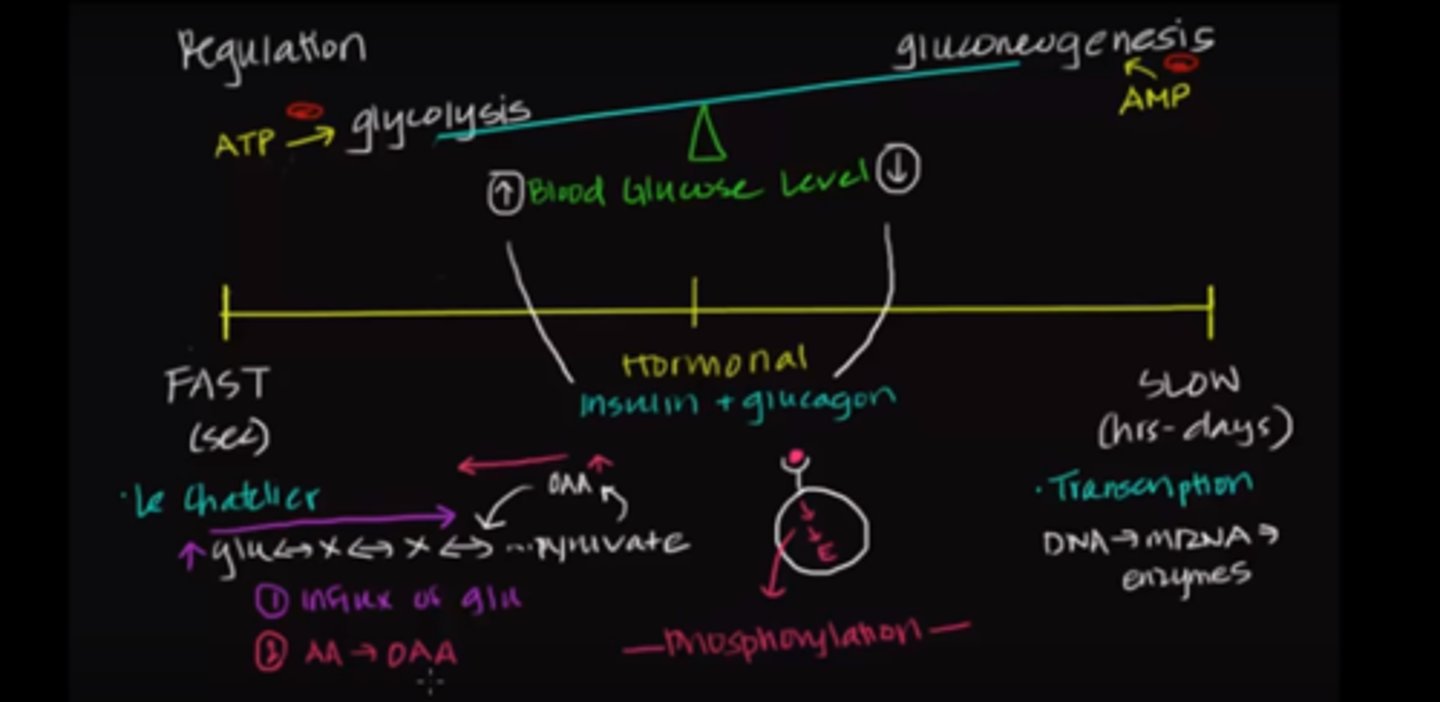
How is the pentose phosphate pathway related to glycolysis?
Various substrates from glycolysis are the reactants for the pentose phosphate pathway.
Struggling to memorize the metabolic pathways (such as glycolysis and beta-oxidation)? Learn them like the back of your hand using Andrew's Metabolic Pathways Mastery Course @ https://mcatselfprep.com/course/andrews-metabolic-pathways-mastery-course/
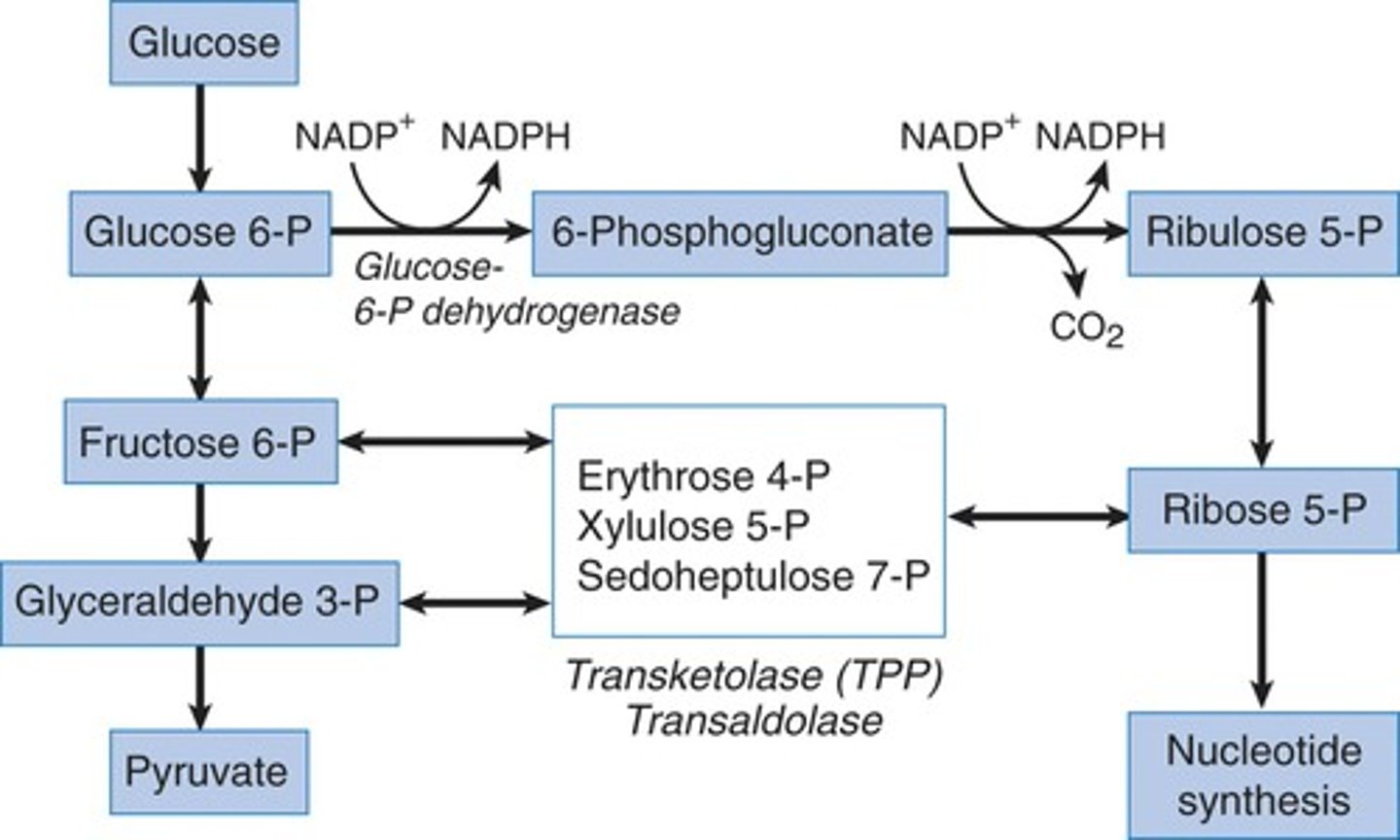
Which of the following are the two main products produced in the pentose phosphate pathway?
(A) Ribose-5-phosphate and NADPH
(B) Glucose-6-phosphate and NADP+
(C) Pyruvate and ATP
(D) Oxaloacetate and FADH2
(A) Ribose-5-phosphate and NADPH
Struggling to memorize the metabolic pathways (such as glycolysis and beta-oxidation)? Learn them like the back of your hand using Andrew's Metabolic Pathways Mastery Course @ https://mcatselfprep.com/course/andrews-metabolic-pathways-mastery-course/

Why is the production of Ribose-5-phosphate important?
Ribose-5-phosphate is a key component of DNA and RNA.
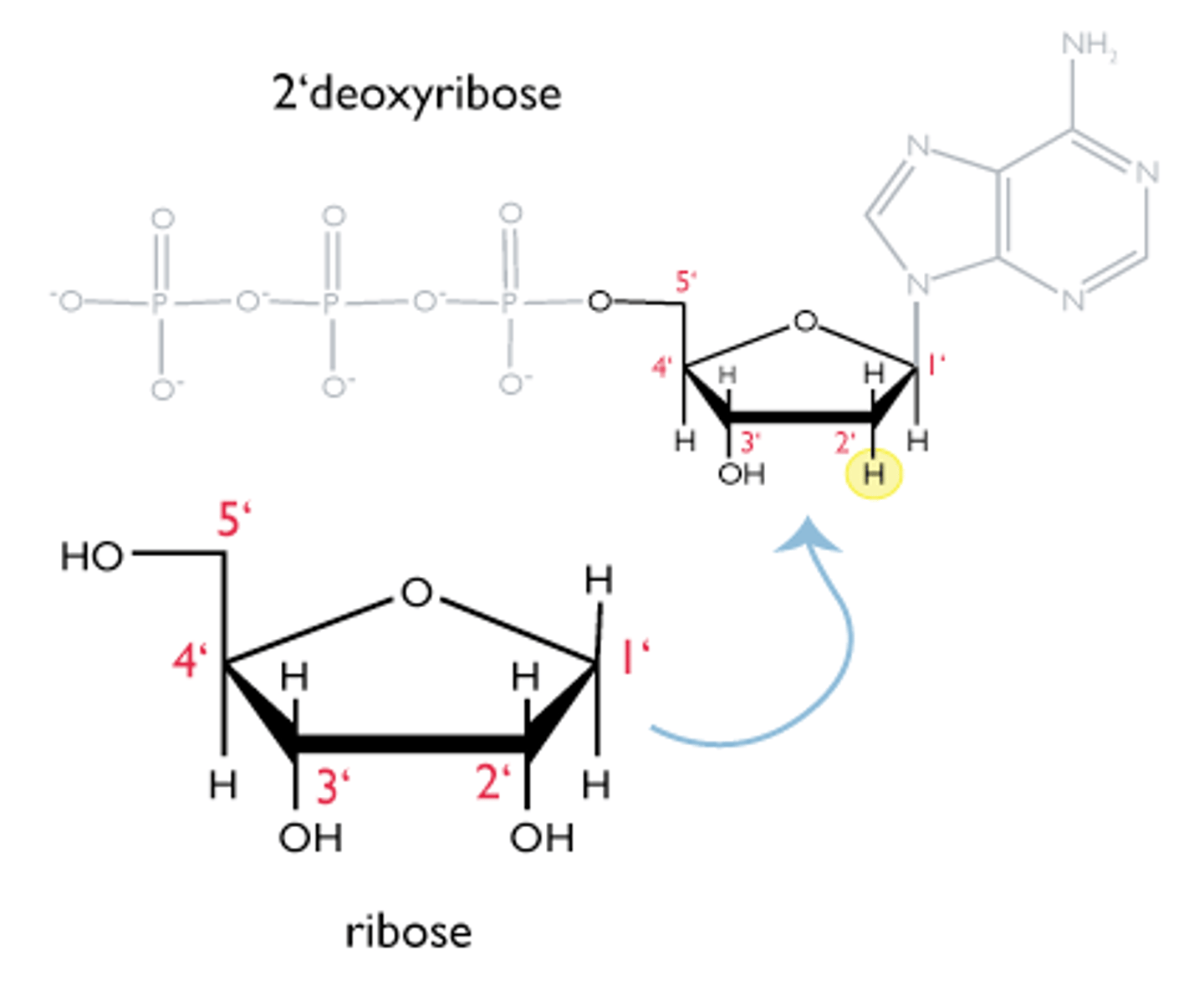
Why is the production of NADPH important?
NADPH is responsible for reducing antioxidants (such as glutathione), converting them into their active form.
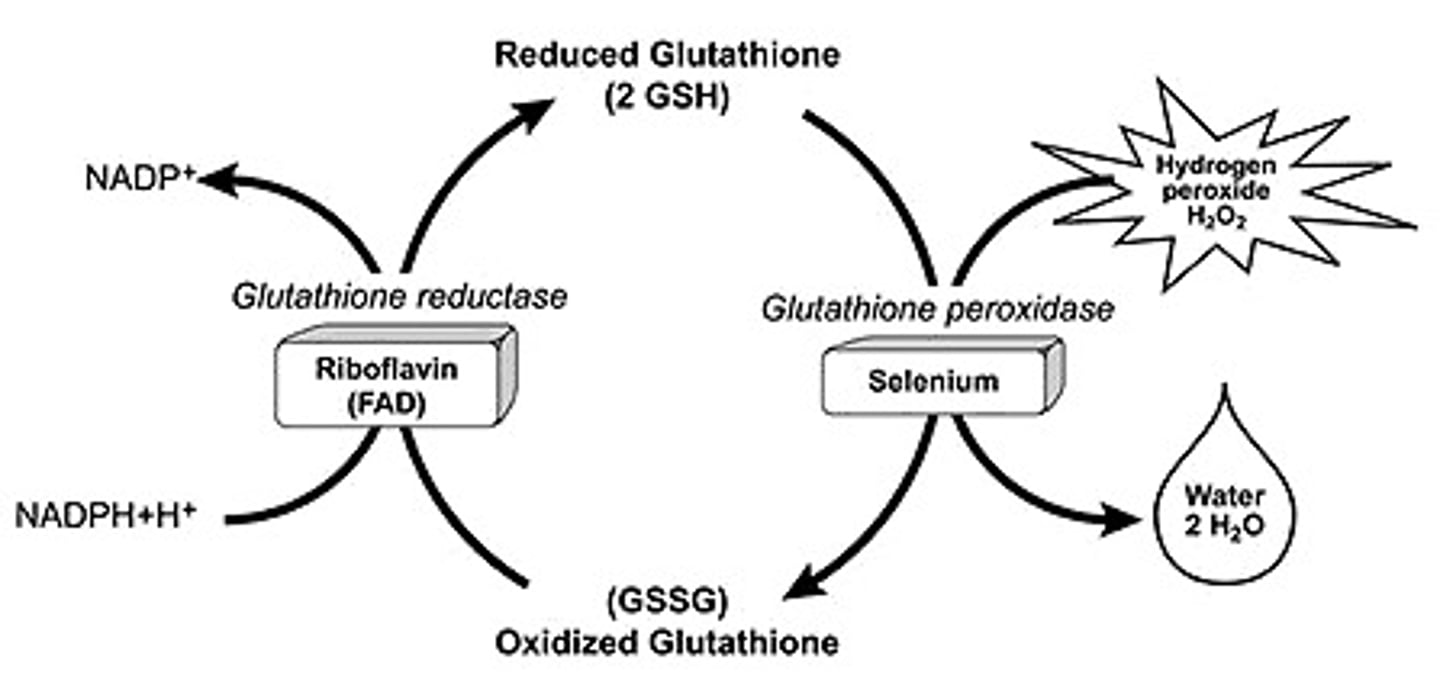
Draw out the oxidative phase of the pentose phosphate pathway, including all the enzymes, substrates, and energy substrates.
It is absolutely necessary to be able to do this for the MCAT. And because it is so challenging to memorize all of this point blank, we've created our Metabolic Pathways Mastery Course: https://mcatselfprep.com/course/andrews-metabolic-pathways-mastery-course/
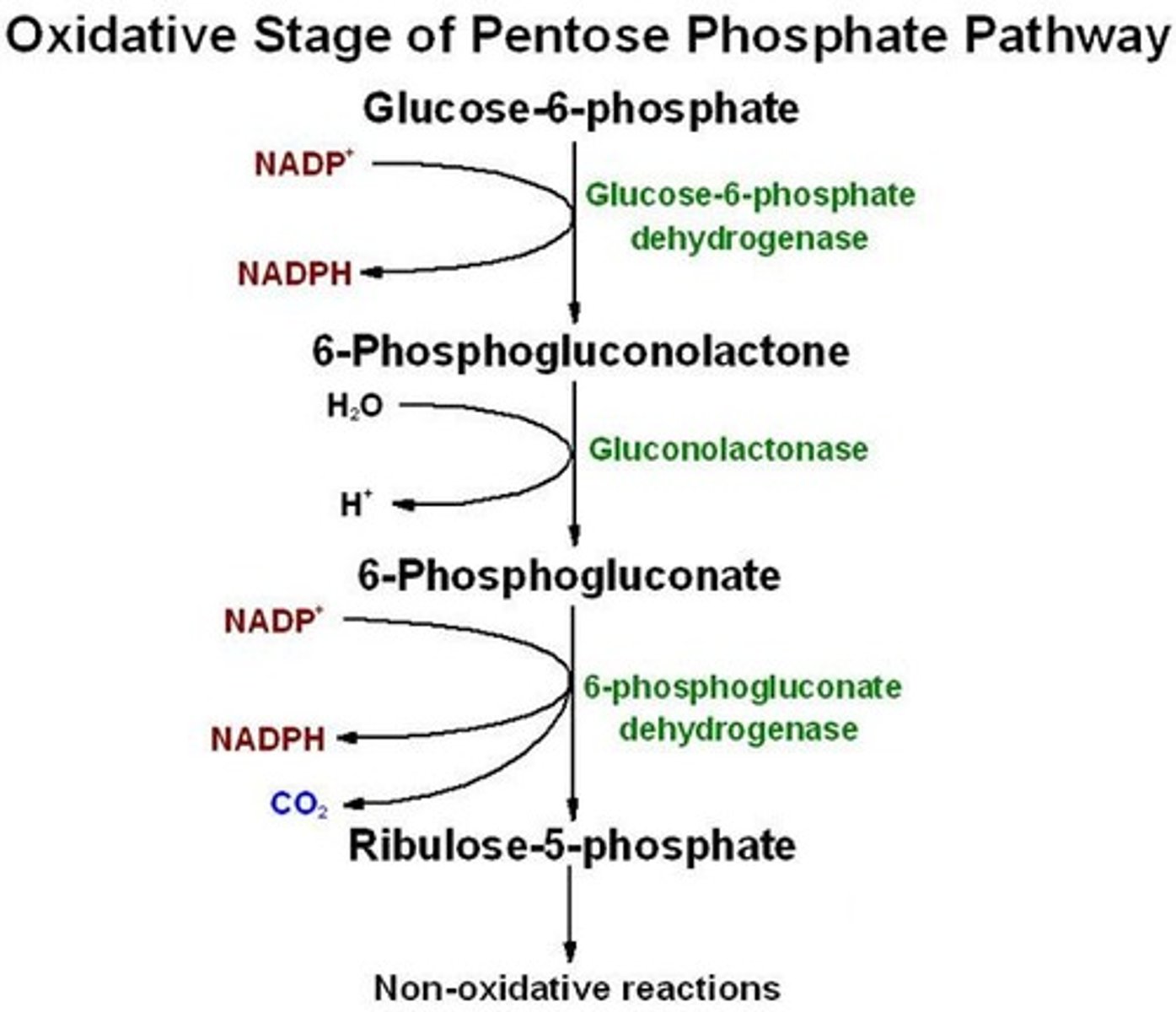
True or False. The purpose of the oxidative phase of the pentose phosphate pathway is to oxidize NADPH and produce ribose-5-phosphate.
False. The purpose of the Oxidative Phase is to REDUCE NADP+ to produce NADPH. It is through the oxidation of glucose-6-phosphate that RIBULOSE-5-phosphate is produced.
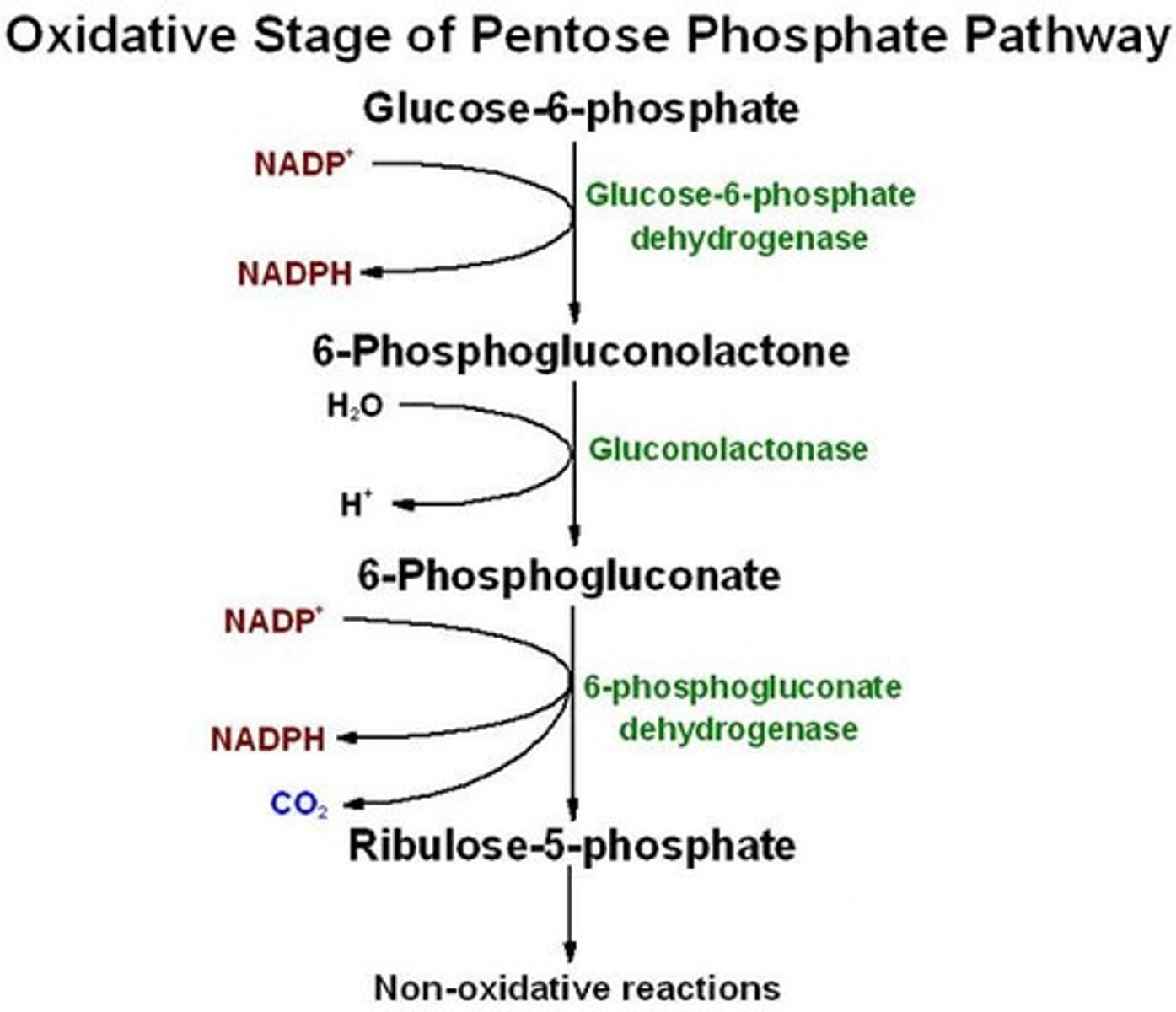
True or False. The purpose of the non-oxidative phase of the pentose phosphate pathway is to produce ribose-5-phosphate and interconvert between sugars found in the pentose phosphate pathway and sugars found in glycolysis.
True. The purpose of the non-oxidative phase of the pentose phosphate pathway is to produce ribose-5-phosphate and interconvert between sugars found in the pentose phosphate pathway and sugars found in glycolysis.
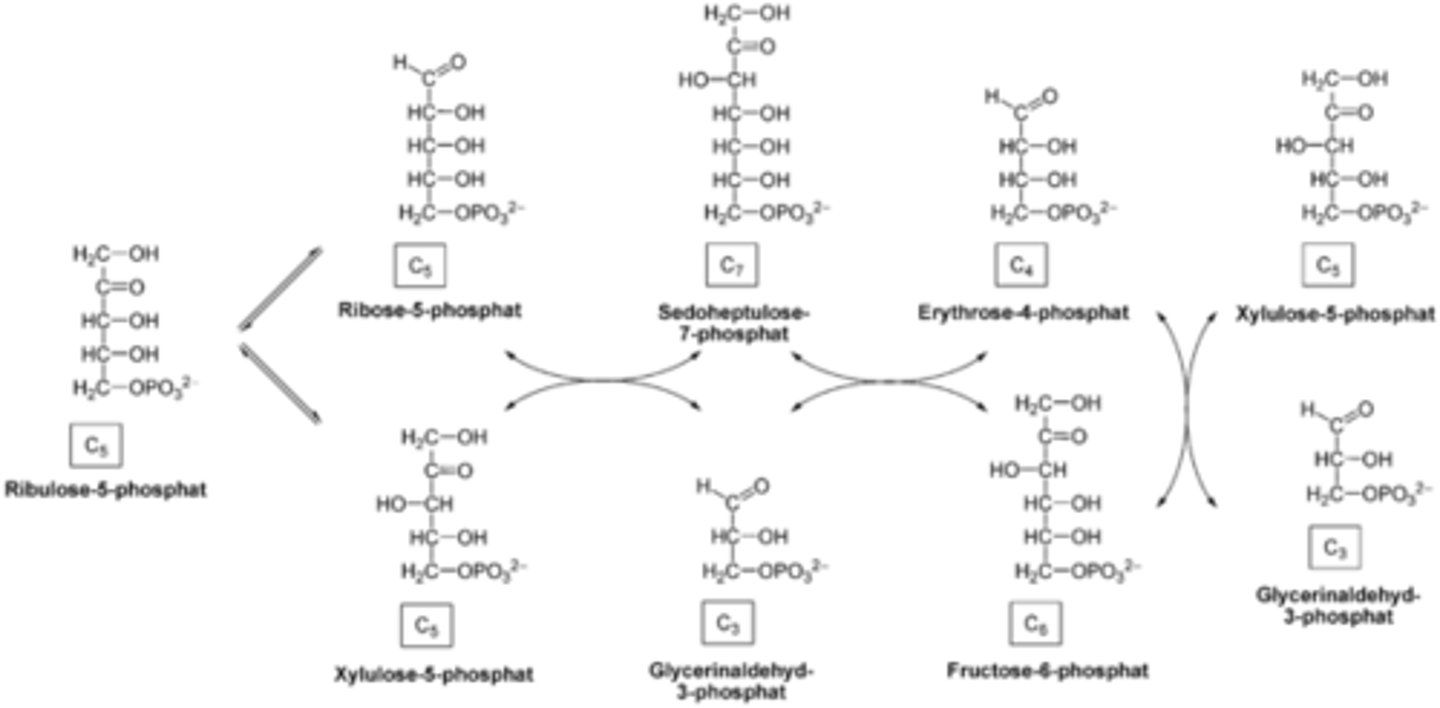
The non-oxidative phase of the pentose phosphate pathway requires which of the following enzymes?
I. Transaldolase
II. Transesterase
III. Transketolase
(A) I and II Only
(B) I and III Only
(C) II and III Only
(D) I, II, and III
(B) I and III Only
While it is not essential to memorize all the substrates involved in the non-oxidative phase of the pentose phosphate pathway, you should at least know that transaldolase and transketolase are involved.
Struggling to memorize the metabolic pathways (such as glycolysis and beta-oxidation)? Learn them like the back of your hand using Andrew's Metabolic Pathways Mastery Course @ https://mcatselfprep.com/course/andrews-metabolic-pathways-mastery-course/

The reactions of the oxidative phase of the pentose phosphate pathway are _______________ and the reactions of the non-oxidative phase of the pentose phosphate pathway are _________________.
(A) reversible, reversible
(B) reversible, irreversible
(C) irreversible, irreversible
(D) irreversible, reversible
(D) irreversible, reversible
The reactions of the oxidative phase of the pentose phosphate pathway are irreversible and the reactions of the non-oxidative phase of the pentose phosphate pathway are reversible.
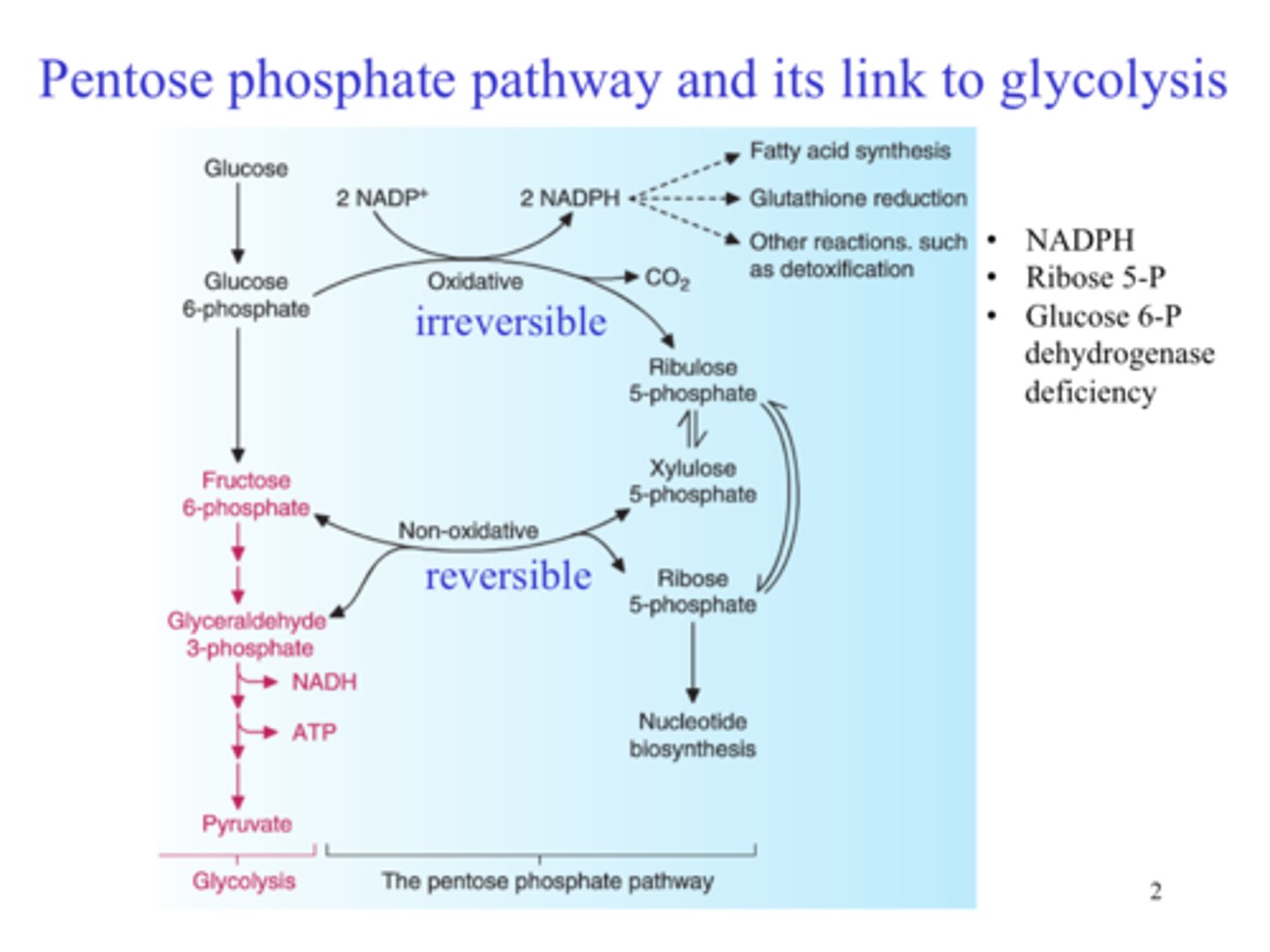
CRB Remember that there are other monosaccharides than Glucose, like Galactose and Fructose.
Fill in the blanks: Galactose can enter Glycolysis as _____________, whereas Fructose can enter Glycolysis as _______________.
(A) Glucose-6-Phosphate, Glucose-6-Phosphate
(B) Glyceraldehyde-3-Phosphate, Glucose-6-Phosphate
(C) Glucose-6-Phosphate, Glyceraldehyde-3-Phosphate
(D) Glyceraldehyde-3-Phosphate, Glyceraldehyde-3-Phosphate
(C) Glucose-6-Phosphate, Glyceraldehyde-3-Phosphate
Galactose can enter Glycolysis as Glucose-6-Phosphate, whereas Fructose can enter Glycolysis as Glyceraldehyde-3-Phosphate.
